




































There’s some great news for those gardeners who love plant nursery catalogues. Thanks to funding from the National Lottery Heritage Fund, a remarkable collection of over 28,000 catalogues held by the RHS are to be made accessible to online audiences. Some of them date back to 1612 and come from a fascinating archive that tracks the gradual changes in gardening and gardening habits through their pages.
The whole enterprise is called the Digital Dig and more than 250 volunteers are being recruited to map the location of all the plant nurseries and make them accessible.
Visit rhs.org.uk/digitaldig
Gardeners in Hampshire been urged to plant a tree for Queen Elizabeth in a scheme which will run until March next year. The Queen’s Green Canopy planting scheme which originally celebrated the Queen’s Platinum Jubilee has been extended as King Charles has urged more gardeners to plant new trees. Each tree planted and recorded in the scheme will join a million already planted and all recorded on a map which stretches from Penzance in Cornwall to the Shetland Islands. “Planting trees for royalty goes back a long way,” said Tony Kirkham former head of Kew Gardens Arboretum. “Where space allows, long lived trees like English oak make the most perfect tribute”.
Visit www.queensgreencanopy.org
This is the last Country Gardener issue of the year and so a perfect opportunity to wish all our readers a happy Christmas and prosperous New Year. We would also like to thank everyone who continues to contribute to the success of the magazine and that includes advertisers, subscribers, our delivery teams, and the hundreds of outlets who stock the magazine.
Next year Country Gardener celebrates its 25th anniversary - something we are very proud of. We will be back with our March issue, available from the last weekend in February, the first of ten issues in 2023. So enjoy the winter gardening as much as you can and again Happy Christmas.
More details continue to emerge from the survey carried out by the RHS including Hampshire into the effects of the scorching heat in the summer and in particular, August. RHS members who completed the survey say the top five plants affected by the exception heat included way out in front hydrangeas followed by acers, phlox, astilbes and Japanese anenomes.
The well known Annalal’s Gallery in the town centre at Christchurch will open for the National Garden Scheme on Sunday 4th and Sunday 11th December. The home of two Royal Academy artists, Anna and Lall Sims, the 32ft x 12½ft garden is on three patio levels. A distinctive ‘Pencil’ gate leads to a colourful scented Victorian walled garden by the enchanting 150 year-old cottage.

Entrance is through the cottage studio/conservatory (leading past a full-sized pony rocking horse) where everything is handmade and sculptured by these Royal Academy Artists. Some works are for sale. Sculptures by Lall and paintings by Anna hide among the flowers and shrubs. There’s an unusual studio and garden room. The garden will be open between 2pm and 4pm on the open days, admission £3, children free. Because of the different levels the garden is unsuitable for wheelchairs. Dogs are not allowed.
Annalal’s Gallery, 25 Millhams Street, Christchurch, Dorset BH23 1DN. Park in Saxon Square public car park. www.annasims.co.uk
Parts of Hampshire are to be named as one of the test areas over the next few months to monitor the range of Government actions to ban retail sales of peat-based composts as part of a coordinated Government action to protect peatlands. The national ban will end peat extraction for horticultural purposes.
Hampshire and areas of Devon and the Cotswolds,
We still don’t know enough about ladybirds and how they aid our gardens it seems. That’s why volunteers are being asked to help researchers find out more. “We are concerned as ladybirds perform such important functions in our ecosystem and gardens and we would like to delve deeper into the habits of what are wonderfully helpful insects,” said Professor Helen Roy of the UK Centre for Ecology and Hydrology.
You can report on ladybird habits at ladybird-survey.org
Jane Austen lovers needn’t miss out when it comes to special events in the build-up to Christmas. On Sunday, 4th December there’s a special Jane Austen village Christmas walk from 12 noon to 1pm which consists of a guided walk to discover the village the author knew and the chance to learn of her love of nature, village life , houses and views she knew and the importance of village life in shaping her writing. Throughout the walk there will be short readings for her letters and novels and include other festive readings and stories.
Jane Austen’s House, Winchester Road, Chawton, Alton GU34 1SD
as well as Cheshire, will be asked to monitor the effectiveness of the ban. RHS director of science, Alistair Griffiths confirmed that the RHS stopped selling peat based growing material in 2019 and plans to work hard to speed up the transition to peat free.
To protect the growing industry from surging demand for peat free products the horticultural industry’s
group Growing Media Taskforce wants to see a legal distinction made between peat used in growing media and allocated to the public and that used by the nursery sector, ring fencing the latter from legislation. Test areas will be involved in how quickly peat products disappear and report on any ‘behind closed doors’ trading.
www.countrygardener.co.uk
Could you join the ladybird detective hunt?

















February is the height of snowdrop time and there are fine displays of these harbingers of spring when gardens in Hampshire open for the National Garden Scheme.
At CHAWTON HOUSE, at Chawton near Alton, Hampshire GU34 1SJ snowdrops and spring flowering bulbs are scattered through the 15-acre listed English landscape garden, which opens for the NGS on Sunday 5th February from 10am until 3.30pm.

Admission is £5, children free. Homemade teas will be available. Sweeping lawns, wilderness, terraces, fernery and a shrubbery walk surround the Elizabethan manor house. The walled garden designed by Edward Knight surrounds a rose garden, borders, orchard, vegetable garden and ‘Elizabeth Blackwell’ herb garden based on her book ‘A Curious Herbal’ of 1737-39.
For other opening times and information go to www.chawtonhouse.org.uk
BRAMDEAN HOUSE at Bramdean, Alresford, Hampshire SO24 0JU opens for the NGS on Sunday 19th February, from 1pm until 3.30pm. Admission is £6, children free and home-made teas will be available. The garden is also open for the NGS by arrangement for groups of five and more.
Contact the owners, Mr and Mrs E Wakefield by email: garden@bramdeanhouse.com
This beautiful plantsman’s five-acre garden that’s best known for its mirror-image herbaceous borders, is also lovely in spring, with


carpets of spring bulbs, especially snowdrops and a large collection of plants and shrubs giving yearround interest; there’s also a oneacre walled kitchen garden and a small arboretum. No dogs allowed except assistance dogs.
LITTLE COURT, Crawley, Winchester, Hampshire SO21 2PU opens for the NGS on Sunday 12th, Monday 13th, Sunday 19th and Monday 20th February, from 2pm until 5pm on all open days.
Admission is £5, children free. Homemade teas will be available in Crawley village hall.
A garden for all seasons, Little Court is especially exciting in spring, with carpets of snowdrops and thousands of crocus which have naturalized under the Victorian apple trees, followed by narcissus; seven contrasting sections of the garden are divided by Victorian flint walls, and grass paths link them.
THE DOWN HOUSE, Itchen Abbas, Hampshire SO21 1AX is a garden that’s open for the NGS by arrangement.
There’s a two-acre garden laid out in rooms to explore, overlooking the Itchen Valley and adjoining the Pilgrim’s Way. See the snowdrops, aconites and crocus, plus borders of dogwoods, willow stems and white birches.
Refreshments will be available, dogs are allowed on short leads and there’s wheelchair access.
For information and booking a visit contact owners Jackie and Mark Porter on 07814 958810 www.thedownhouse.co.uk
1ST
Romsey Organic Gardeners ‘A HISTORY OF FURZEY GARDENS’ - JULIA BAKER email: johnv61@btinternet.com
5TH
Ferndown and District Horticultural Association
QUIZ - DAVID BASSIL Details on 07790 089889
The Highcliffe & District Horticultural Society
AGM & CHRISTMAS SOCIAL Details on 01425 274537
13TH
Lymington Gardeners Club
‘ROSES’ - STEWART POCOCK Details on 01590 672909
19TH
St Alban’s Club
MONTHLY MEETING
Milford Gardeners Club CHRISTMAS SOCIAL EVENING Details on 01425 612287
5TH


Romsey Organic Gardeners ‘ORCHIDS, WILD AND BEAUTIFUL’ - PETER ASHBURN email: johnv61@btinternet.com
10TH
Lymington Gardeners Club ‘HISTORY OF FURZEY GARDENS’ - JULIA BAKER Details on 01590 672909
2ND
Romsey Organic Gardeners ‘SOIL MANAGEMENT’
- RAY BROUGHTON email: johnv61@btinternet.com
14TH
There are still a few December days left to visit the exhibition: ‘Drawn From Nature: Gilbert White and the Artists’ at Gilbert White’s House & Gardens in Selbourne which is open until December 11th. It is a stunning display of works of art by contemporary artists inspired by Gilbert White’s work and commissioned by the Pallant House gallery for their 2020 exhibition of the same name. It includes images of the extraordinary array of wildlife described by White. The exhibition also features prints from the museums own collection. Gilbert White’s House & Gardens, High Street, Selborne, Alton GU34 3JH
Exbury Christmas Fair will again be welcoming guests to the popular gardens venue which takes place over the weekend of Saturday and Sunday, 3rd and 4th December and Saturday and Sunday 10th and 11th of December. The fair will be full of stall holders with seasonal goods, gifts, food and drink together with live music and face painting. Exbury Gardens, Summer Lane, New Forest SO451AZ
www.countrygardener.co.uk
Lymington Gardeners Club ‘PRIMULAS AND AURICULAS’ - ALAN EDMONDSON Details on 01590 672909
If your gardening club or association is back in full swing with events and meetings after the restrictions of the past couple of years, then be sure to let us know. Send your club meetings and details to timeoff@countrygardener.co.uk
I don’t want to tempt fate but I’ll take any bet you like we’ll be in for a damp maybe genuinely wet, perhaps miserable, often grey -but not a bitterly cold long frosty winter.
So that means as over the past few years I ignore the gap that people label the winter months and keep on sowing.
It worked last year, and I think it’s an important message for us gardeners who like to be out there doing all year long.
So my message is the winter months have started to create a real precedent for gardeners to sow crops during the heart of winter.
Winter sowing gives vegetables a head start for the spring harvest. Some seeds even germinate at a higher rate when sown in winter.
What I have found is that in Dorset and I am sure it is true throughout the south west, you can plant certain vegetables in the winter without changing your gardening habits.
You can direct-sow seed into garden beds or start your seeds in containers.

Direct sowing is the simplest method, but your seeds are likely to germinate later because the soil will take longer to warm up in the spring. That’s why many gardeners opt for starting seeds in containers then transplanting them in the spring.
When direct sowing, you can plant seeds anytime, if the ground has thawed enough to work the seeds into the soil. The seeds will remain dormant until the soil temperature is right for them to sprout in the spring. This is better for crops like leafy greens, which tend to bolt once the weather gets too warm.
For containers, I plant after the winter solstice, in January or early February. This way they’ll still have plenty of time to mimic natural germination condition and seeds suited to those climates won’t require a frost, so your timing can be more flexible.
So, what do I mean by cool season crops? Cool season crops germinate in cold soil and mature with cool weather and short periods of daylight, meaning they are perfect for planting in early spring. Pea, onion, and lettuce seeds will germinate as low as 35°F (10°C ), meaning they can go in the ground if it’s not frozen and not too wet.
So, if you love tending to (and eating) your own homegrown crops, there’s no need to stop over the winter months.
Some of the best winter veggies aren’t just tasty, but they’re beautiful too.
Winter doesn’t mean it’s the end of the growing season. If you’ve really got into growing your own fruits and vegetables, with all its environmental and health benefits, there are many delicious crops that flourish in the colder months.
Some will be ready to pick and eat all through winter, you’ll be giving others a head start for earlier crops once the weather warms.
Garlic - planting in winter will help you get ahead for
next year, plus it will give the bulbs a longer period to bulk up.
A staple of the winter vegetable garden, if you plant Swiss chard out in late autumn and I mean November, you’ll get plenty to pick before Christmas. Then, it will regrow again in time for spring. And if you keep picking them, the leaves will keep coming.
Swiss chard is the best variety for taste, plus you get the bonus of the lovely yellow and ruby-coloured stems.
Salad greens, like lettuce and spinach, are some of the heartiest plants in the garden that can withstand cold temperatures. I plant a few salad greens seeds every week and I can harvest groups of salad greens at different times, through the season. I like to pick them when leaves are about four inches tall.
Parsnips can even survive the winter, to be harvested in the spring. Parsnips are a perfect crop to plant in late winter, because ideally, they should experience two to three frosts before harvesting. My seedlings emerge in a couple weeks.
Peas are one of the earliest starters on the allotment, and according to The Old Farmer’s Almanac, peas can even handle being snowed on! I plant as soon as the ground can be worked, which was late December last year.
According to The Old Farmer’s Almanac, “a blanket of snow won’t hurt emerging pea plants, but several days with temperatures in the teens could. Be prepared to plant again if the first peas don’t make it.” I start mine in a cold frame.
Turnips are cool weather plants that like to be sewn in autumn or late winter. You can sow turnips in the ground as soon as the ground is workable, but healthy turnips might need a cold case over them to raise the soil temperature to 40°F.

Early radish varieties grow easy and fast, and they love the cool temperatures of late winter and early spring. Plant as early as the soil can be worked in a cold frame. One of the most effective ways to protect early crops from cold is to grow them in a cold frame. I have a couple on the allotment. Cold frames or cloches don’t have to be expensive and are after all simply four walls and a glass pane. The best thing about cold frames? They encourage higher temperatures around the plants, creating a greenhouse effect.
If not, apply generous mulch and straw to plants when you’re expecting a freeze. Frost has the benefit of sweetening winter vegetables and enhancing their flavour.
So come on winter, show me what you’ve got. I’m ready for you and plan to be kept busy.
Dorset allotment owner Mark Hebden is now a firm believe that the recent series of mild winters means everyone should be sowing crops over Christmas.
A new Hampshire initiative is delving into how we have been more aware of how important nature is to our health and wellbeing with many of us turning to it for support, or just a change of scene
A new Initiative is growing support through Hampshire to copy a scheme formulated in Scotland which links well-being in humans and the support and care of nature.

Up to twenty professionals have been studying the scheme which hopes to emulate it in the New Year after a period of studying and trying to emulate how it has operated in Scotland.
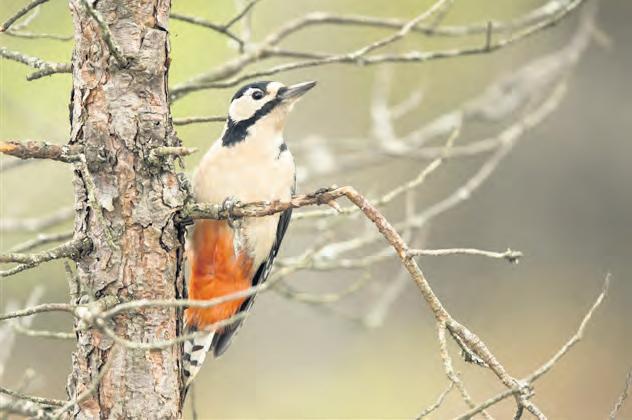
The direct links between exposure to nature and a range of health benefits inspired RSPB Scotland to create Nature Prescriptions, an initiative which provides an innovative way to support the health of people and nature.
Nature Prescriptions began as a collaboration with NHS Shetland in 2017 and everyone can now share the results from an Edinburgh pilot that tested the approach in an urban setting thanks to support from Edinburgh and Lothians Health Foundation.
For the first time, it can offer hard evidence of the value of Nature Prescriptions to both patients and healthcare professionals and provide guidance on how this approach can be effectively delivered in a primary care setting.
There is an ever-increasing body of evidence demonstrating direct links between exposure to nature and a range of health benefits, including reductions in anxiety, fatigue and depression, lower rates of inflammatory-based diseases, type 2 diabetes and obesity, improved concentration, enhanced immune function and reduced mortality. Nature also has positive impacts on levels of life satisfaction, vitality and happiness.
Nature Prescriptions are designed to support GPs and other healthcare professionals to formally prescribe connecting with nature so their patients can harness the benefits of nature for health and wellbeing. They use their medical knowledge to choose when a prescription is appropriate and then customise it to an individual patient’s needs and abilities as part of their treatment.
The prescription is supported by a leaflet and a calendar of local, seasonal activities produced by RSPB Scotland along with some information about local greenspaces and groups.
Nearly 350 patients across all age groups received a Nature Prescription. Prescriptions were given for 32 different conditions, most (69 per cent) were given to support mental health, with 17 per cent given to support physical health and 10 per cent for both.
Nearly three-quarters of patients who provided feedback said they had benefited from their Nature Prescription, with most continuing to connect with nature each week, and 87 per cent of them saying it was likely or very likely that they would continue using their prescription.
The formal prescription was liked because it gave patients the permission and motivation to engage with nature, it was a drug-free safe alternative and they thought it was working.
“I have lived in Edinburgh for over 10 years but honestly had no idea where to go for woodland walks, so the maps and suggestions were fantastic. It is so easy to forget how good nature makes you feel, especially in winter and throughout the pandemic. Thank you!” Patient
“I’ve been reminded of all that nature has to offer. I share my love of nature with friends and I’ve noticed how it has benefitted them as well. This prescription has shone a light on something that brings me a lot of joy and that’s always there no matter what. Being connected with nature calms me and makes me feel grounded. It gives me perspective and lifts my heart. Thank you so much for this inspired service. Absolutely brilliant!” Patient
Most patients did not experience any issues with using their nature prescription. The main challenges to helping patients get the benefit of a nature prescription were felt by the prescribers who mentioned that both time pressures and virtual appointments made it harder to have conversations with patients and ensure they understood the benefits connecting with nature could give them.
Despite this, by the end of the pilot nearly 90 per cent were prescribing nature and they all said they would continue to do so. Before the pilot, only 39 per cent of prescribers were recommending nature-based activities.
“It’s great to have something specific to offer to patients that isn’t medication.” GP, Leith Mount Surgery
Media coverage of Nature Prescriptions in Shetland led to ongoing interest from healthcare professionals around the world. However, our ability to measure success was largely based on anecdotal evidence and we wanted to undertake more thorough research to investigate both the benefits of prescribing nature and how best to do it. We also wanted to test if it could work as well in an urban area.
So, with the support of Edinburgh and Lothians Health Foundation) and start-up funding provided by the RSPB, an Edinburgh pilot of Nature Prescriptions was formed working with five GP practices across the city.
The pilot was due to begin in spring 2020 but was delayed due to the onset of the Covid-19 pandemic. It was restarted in November that year, despite ongoing pressures, as GPs were keen to begin with one saying that “Nature Prescriptions is needed now more than ever”. Some of the activities planned for Hampshire may include physical activity in nature (green exercise), but Nature Prescriptions is about more than being active outdoors, it’s about connecting in a personal and meaningful way. While the focus is very much on individual connections, it can also work in group settings or as part of social prescribing approaches.
www.countrygardener.co.uk
Christine Brain, head gardener at National Trust’s Barrington Court, and a pioneering female head gardener in the South West, has retired after 44 years working at the garden.
The four decades of her career have seen big changes in horticulture in the UK, with many more women professional gardeners. When she trained in the 1970s she was the only girl in a class of 25 studying horticulture. After qualifying at Cannington College she had the opportunity of becoming head gardener at the historic property, and there she has stayed until her retirement.
Gifted in 1907, Barrington Court was one of the National Trust's earliest acquisitions. Attached to the village of Barrington near Ilminster, the 16th century Tudor manor house was rescued in the 1920s by Col. Arthur Lyle whose family was part of the Tate and Lyle sugar company. He took on a lease and created a model estate, filling the house with salvaged panelling, fireplaces and staircases, putting in place a large kitchen garden that’s still productive, and ornamental gardens influenced by Gertrude Jekyll.
Col Lyle’s wife Elsie consulted the famous garden designer, who by this time was in her seventies, nearly blind and didn’t travel to other parts of the country. But she advised the Lyles on the garden plans, and what would grow well in the limy soil by crumbling the soil that they sent to her in biscuit tins!
There have been the inevitable changes, including the introduction of the White Garden, formerly the Rose and Peony Garden, as the roses became ‘rose-sick’ so were replaced and the whole area was transformed with its circle of beds planted with white herbaceous plants and roses, white wisteria and Solanum jasminoides. The White Garden has become one of the most photographed areas at Barrington Court.
The vast kitchen garden of just under an acre looks as if it has been there for centuries; with its central pool and statue of the boy with the dolphin, espaliered fruit trees around the walls, trained fruit trees along the wide paths,
She worked with Col Lyle’s grandson Andrew Lyle on changes in the garden until the Lyles gave up their lease on the property in 1991, when the National Trust took over the entire management of the property.
In the 1980s she and Andrew Lyle designed the Jekyllinspired pergola that’s to be found near the 18th century
The garden ‘rooms’ of the walled White Garden, the Rose and Iris Garden and the Lily Garden all show Jekyll’s design principles, with playing fountains, and vibrantly colourful, scented plants. The Arts and Crafts atmosphere remains throughout the garden with the emphasis on craftsmanship in the lovely herringbone and basket weave patterned brick paths.
and rows of vegetables which supply the restaurant and plant sales, it is as visually impressive as it is productive.
In 2011 Christine Brain spoke to Country Gardener, and told us of the changes she has seen while working there, with the Barrington Court garden becoming much more ecological over the decades.

“We don’t use peat, and increasingly we don’t dig. When I started here there was an old gardener who spent practically the whole winter just digging over the kitchen garden. We started no-digging in small sections and now most of the area is done that way, with compost spread over.”
“Not only does it save the back, it doesn’t do the soil much good to keep walking over it, and we still have good results. We’re also more health and safety and also energy conscious – we have started using rechargeable battery operated hedge trimmers.”
The visit of the then Prince of Wales, now King Charles, in 2007, to celebrate 100 years since the trust's acquisition of the house was the "most memorable event" of her career.
"It was a perfect sunny day and then there was a thunderstorm overnight, so it was perfect," she said.
Over the years that Christine Brain has worked at Barrington Court there has been a succession of outside influences on the property, with climate change making a difference as to how and when they plant flowers, and a dramatic increase in visitor numbers with the latest count at around 125,000 a year.
buss stalls originally used to house calves, which were due to be pulled down and rebuilt elsewhere in the original 1920s garden design. The quiet, tranquil area is part of the history of the garden, marrying the different historical eras.
"Barrington Court is a special place and one of my favourite things about the garden is the peace and quiet, it has a wonderful atmosphere,” said Christine, who lived on site and must have enjoyed the quiet when the visitors went home at the end of the day.
"Each part of the garden is special in its own way, where each season brings changes and no two years are the same."

Christine has passed on her years of able experience to gardeners in giving talks around the region, and has trained many professional gardeners including another female head gardener, Claire Greenslade who became Formal Gardens Supervisor at Hestercombe Gardens near Taunton.

A spokesperson for the National Trust added: "Under Ms Brain's leadership, the care of the garden has continued to pay homage to the 1920s design and structure."
Barrington Court, Barrington, near Ilminster TA19 0NQ For winter opening times and ‘Enchanted Woodland at Barrington’ events call 01460 241938 or email barringtoncourt@nationaltrust.org.uk www.nationaltrust.org.uk/barrington
We don’t use peat, and increasingly we don’t dig. When I started here there was an old gardener who spent practically the whole winter just digging over the kitchen garden"
A pioneering gardener's work which started as a student, always paid homage to the 1920s design and structure as developed by Colonel Lyle and his wife Elsie which was influenced by the Arts and Crafts movement.Barrington Court was one of the National Trust’s earliest acquisitions

As the colder months approach, many people believe the gardening season has ended and they must wait for the spring for their gardens to thrive again. The good news is this is not true. Getting in the garden in the winter will reap rewards come the spring and summer, and it is a great time to take stock and do some planning.
Do your best to protect your plants during the cold, winter months even if they do thrive in colder conditions. Clear heavy snow from trees and shrubs but allow ice to naturally melt and provide some water to your garden.
If you have any tender plants bring them inside, or for those that are slightly hardier, wrap them in fleece or bubble wrap, to keep the frost off.
While keeping an eye on the weather forecast goes hand in hand with gardening, there are a few environmental conditions that will typically lead to a frost.

Cloudy nights help insulate the earth from sudden swings in temperature, but clear skies have a cooling effect that allows heat to escape into the atmosphere.
When a frost is in the forecast, wait until dusk and move your potted plants and hanging baskets indoors.
Plants situated in containers are more prone to frost damage since they won’t benefit at all from the insulating powers of the earth, like in-ground plants would.
Potted plants are much more susceptible to root damage in colder temperatures.
Many vegetables thrive during the colder, winter months. Broccoli, Brussels sprouts, cabbages, and parsnips (which have an improved flavour as frost helps with the process of turning starch to sugar) will all withstand the wintery air.
Carrots, onions and turnips can also be grown during the winter months as well, but only if they are protected well. Place a layer of straw over these vegetables to stop the harsh frost damaging the roots.

Winter is a great time to polish your tools and re-organise your garden shed. After you have cleaned and sharpened your tools, winter-blade tools can be stored in an old pot filled with a mixture of vegetable oil and clean sand to keep them from rusting. If you own electric tools for gardening make sure to store these in a dry, warm place as freezing temperatures can cause the plastic or metal on some tools to become brittle.
Always remove all of the soil from your digging tools after each use. Usually hosing is all it takes, but use a screwdriver to remove caked or dried mud.
Never put your tools away wet. Allow them to dry completely before storing to prevent rusting and handle rot. Once each garden season, rub linseed oil into your wooden handles to help preserve them.

After each use wipe the metal parts of pruners, shears, and loppers with an oily rag.

Alternately, you can wipe your tools dry with a clean rag, and then spray lightly with a penetrating oil such as WD40.
A harsh winter can be a difficult time for wildlife in our gardens, but we can all lend a helping hand. Feeders full of nuts and seeds will help the birds, and a pile of logs and leaves will be a haven for a hedgehog looking to see through the winter months.
Winter is the perfect time to do some reorganisation and prep work. Consider the coming year, your garden layout, and any changes you’d like to make and prepare any perennial beds for spring regrowth. And while you are doing some tidying, keep an eye out for foliage that might help you decorate your home or help make the perfect dinner setting for Christmas.
The best time to prune is after flowering. If the plant needs to be renovated, or severely reduced, this can be done late winter and early spring just before growth begins. Remove old flowers (deadhead) and cut back to healthy outward facing buds.
The bare branches of winter can make it easier to see what needs to be shaped and trimmed in your garden. Pick one of the milder, sunny days to get out and do some pruning. January is the month for cutting back apple trees, and if you have hibiscus in your garden, pruning during winter can help encourage growth for spring.
Keep a watchful eye on the long range forecast and suspend pruning when a severe drop in temperature is forecast. Recently pruned trees can be damaged when temperatures suddenly drop.
Prune rose bushes in January while they are still dormant. Cut branches back to just above a bud, making sure to remove any crossing or dead branches. January is the month to start pruning rhododendrons.
Some trees flower in spring, like dogwood, magnolia, redbud, cherry, and pear. As with spring-flowering shrubs, these trees should not be pruned in winter since you will remove the buds that would otherwise light up your garden in spring.
Head gardener Mark Dwelly suggests staying busy and active, and offers his tips on gardening during the winter months

Have you ever seen a hedge that is all woody underneath with a thin layer of greenery on its domed top? Regular hedge trimming will keep a shrubs surface shape, but the woody stems will thicken and harden over time. These look ugly and may eventually result in unnecessary deterioration of the plant.
Hedge regeneration involves either pruning out the old stems and/or pruning back all branches to encourage fresh shoots in spring. The extent of the pruning will depend on how it has been pruned in the past or vary with species. Roses are an example of a plant that benefits from regeneration (but not all roses).
Now that the leaves have fallen, it is a good time to remove unwanted plants or have a big garden makeover. There is less plant to dispose of and you can see what you are cutting.
If ivy or brambles are a problem, the winter can be a good time to remove them as they are easier to see among branches that have lost their leaves.
Winter is a great time for gardeners to take stock, tidy up, protect plants and plan ahead.It can feel like a gloomy time in the garden. However, there is still much to be done.
From looking after your garden tools, to splitting plants and planting bulbs for the seasons ahead, getting outside in your garden in the winter months can be rewarding and give you a chance to breathe fresh air and stay connected to the outdoors. Just remember to wrap up warm and reward yourself with a hot drink afterwards!
Now that you can see your garden in its bare bones, what repairs are needed? Plan ahead, what plants will need supports as they grow? Add them now.
• Does your shed have a leaky roof?
• Do you have a water butt ready for the winter downpours?
• Do you have a compost bin in place?
• Has your fence blown down?

• Will newly planted climbers need new trellis or supports?

• Loose paving?
• Slippery paths can be pressure washed.
Now is the time to do these tasks - you might not have time during the growing season.
Winter is the perfect time to dig a new border. Leave the soil in clumps. The winter rain and frost will help to break it down naturally. This will also expose any pests to natural predators and the cold.
Digging over vegetable plots or preparing New ones can also be done during winter for the same reasons.
Is your lawn bumpy? The winter is a good time to remove sections of turf, add/remove soil and relay. Some plants are dormant during the winter so they can be supplied as bare root plants (with no soil). Roses are often bought this way.
It might be possible to safely dig up and move dormant plants to another part of the garden.

If the soil is not frozen or waterlogged, these dormant plants can be planted before they ‘wake-up’ in the spring. Bulbs are often planted in late autumn. Herbaceous plants are often divided and replanted in early spring. When this happens will likely depend on your local climate.
Collect up ash from your all-wood fires (i.e., only those without coal) and sprinkle it around fruit trees and roses. It is rich in potassium, so encourages good flowering in spring, and hence good fruiting in autumn.
Dahlia cuttings produce bigger flowers than tubers. So, pull your tubers out of dormancy, nestle them into trays, water, then stand them on a heated propagating bench. When the shoots reach three to four inches you can start taking cuttings.
If you have an allotment, and you’re not planting a crop to over-winter, cover your empty veg beds with landscaping fabric or cardboard and weigh it down with planks and bricks. This will keep the weeds down over winter, and the soil will warm up quicker in spring. Covering beds also prevents loss of nutrients from the soil due to rain and wind.

Too many gardens turn their backs on places to sit outside in winter. Maybe this year it is something you ought to give some thought to. What’s genuinely surprising is how many different spots in the garden capture warm(-ish) winter sun. You might need to identify the sunniest place for morning coffee and another for afternoon tea but it’s worth it and it feels like a discovery, even if you’ve had your garden for years.
The first frost could be just days away, so gardeners will need to protect plants from the first frost of the year, helping them survive over the winter.
What are the causes and impacts of frost damage on your garden?

Frost is caused by cold, clear, still nights when the air drops below freezing. You can get a ground frost (affects lawns and roots) and an air frost (affects stems, leaves, flowers and fruit). Water in the plant’s cells freeze, expand, and then burst leaving the plant unable to take up water and nutrients.
When soil or compost freezes for any length of time then roots are unable to take up water and the whole plant will show signs of drought and may eventually die.
Short term frost damage can often be reparable but rapid thawing can be fatal as can long term extreme frost.
What are the signs of frost damage?

Snowdrops spread by seed and will expand about three cms in all directions per year. To help them spread more quickly, dig and divide them immediately after they’ve flowered and replant about 30cm apart. If you’re planting them from fresh, planting in the green in February is usually the best route to success.
Winter is the best time to plant shrubs, small trees, climbers and hedging that will attract and help wildlife in the months ahead. For example, plant a Cotoneaster sternianus shrub to provide bees with summer nectar and birds with autumn berries; edge a border with a low hedge of lavender to feed bees and butterflies in high summer; and plant a range of dense, evergreen climbers (such as ivy) and shrubs (such as Euonymus fortunei ‘Emerald ’n’ Gold’) to create shelter and nesting sites for birds.

Fruit trees are dormant now, so it’s safe to prune them. Remove dead, diseased and damaged wood, and eliminate any instances of branches crossing and rubbing against each other - remove the weaker one. Wear gloves, use sharp, clean tools, and cut at an angle, so that the face of the cut angles downwards, allowing rain to run off it and preventing it rotting.
More jobs to tackle during the winter months include
• Tie back climbing plants.
• Clean and tidy the greenhouse or polytunnel ready to receive spring plants.
• A little light weeding now will save time in spring.
• Mulch around trees, shrubs and herbaceous perennials mulch.
• Clear gutters on garden buildings.
• Build raised beds and fill them with good quality soil ready for growing your own fruit and veg.

Take stock of your gardening year. Do not be disheartened by your gardening imperfections or failures, but devote some time to pondering what you will do differently in the coming year.
Black scorching and brown patches on leaves are tell-tale signs of frost damage. Wilting, and shrivelling leaves turn black and the stem of the plant tips over. You’ll also notice your plants being pushed up from the soil in the ground.
What are some hardy plants that survive the frost?
Hardy, native plants, and those that are used to colder climates survive best. Trees and shrubs with thick bark will survive as their bark acts as an insulator, keeping heat in. Deciduous trees and shrubs that lose their leaves will also survive, as there’s less risk of cell rupture.
What are the plants most susceptible?
Tender and exotic plants such as bananas, cannas, dahlias, tomatoes, courgettes are the most susceptible to frost, and will need the most attention to help keep them protected.
and near a wall or under trees and shrubs, and avoid planting in a frost pocket such as at the bottom of a slope. Be wary


planting susceptible plants in
east-facing situation, as the early morning sun can cause rapid
Cover your plants with horticultural fleece, easily found in garden centres and DIY stores or wrap pots in bubble wrap to help keep heat in over the colder months.
Another tip is to leave pruning of plants such as penstemon, salvias and fuchsias until late spring to allow the older growth to protect the central crown.
What are some tips to treat frost damage?
Don’t prune out damaged growth until the risk of frost has definitely passed, otherwise you risk exposing any new growth to damaging spring frosts. It’s never too late to wrap fleece around your plant!
Do vegetables need protection?
Summer vegetables such as tomatoes, courgettes and peppers will not survive a frost and are treated as annuals. However, some people have success overwintering chilli plants indoors where they keep them alive ready to start growing again in the spring.
Many vegetables can be grown outside in the winter including Brussels sprouts, cabbages and leeks. Did you know, leeks benefit from frost as this encourages them to become sweeter! The sugar in the plant can act as a natural anti-freeze.
What are some simple steps that can be taken to protect plants from frost? What’s the best materials to use for cover?
As for outside, group containers together
of
an
thawing.
On 1st December, applications for horticultural workbased training open across all RHS gardens opening career opportunities for thousands in an industry which has changed beyond recognition since Covid
A career in horticulture has never been so much in demand and in a few years’ time it is expected that 750,000 will be earning salaries from getting their hands dirty.
The Royal Horticultural Society (RHS) has seen close to a 25per-cent increase in applications for its diploma in Horticultural Practice, nearly six times as many applicants as places. For the second year running the majority (57percent in 2022) of applicants are female.

The changes over the past few years have been dramatic. Researchers believe Covid changed things forever -introducing people into gardening for the first time who then went on to try and make it into a career.
The significance is also that an industry recently criticised for not having a high enough skill set is now seen as a high quality business with a competitive element when it comes to training and to job applications.
This is also the time of the year when applications for those who want to turn interest into a career have to be really focussed.
At the front of the industry is the RHS who consistently provide unique opportunities to gain hands-on skills and experience alongside experts, to prepare for life in industry, and are fully paid positions meaning zero debt at the end of training.
For those that love the outdoors but are new to horticulture, the Level 2 Horticultural Apprenticeships require no prior experience or qualifications. These two-year, full-time apprenticeship opportunities are available across all five gardens and are a mix of college (block-release) and workplace learning. RHS Garden Rosemoor in north Devon are offering two Level 2 positions, plus one Level 3 Horticulture Supervisor apprenticeship, which is over three years.
For those with some experience and an existing Level 2 horticultural qualification wishing to grow knowledge and skills at a supervisory level, then the Level 3 and
Level 4 Diploma in Horticultural Practice at RHS Garden Wisley offers a formal qualification, regulated by Ofqual, providing students with an intensive learning experience over two years.

Students rotate around the garden learning about all areas of ornamental horticulture, whilst training alongside inspiring professionals to develop supervisory skills, including management practices, budgeting and communication.

Students are actively involved a range of opportunities such as helping at RHS shows like Chelsea, designing and building a garden in the local community, visiting gardens, bursary opportunities and managing their own allotment space. There are ten opportunities available on the diploma programme, where student accommodation is available, so re-location is possible.
The RHS also offer a number of one-year Professional Work Placement positions across all five gardens. Like the Diploma, some experience and a Level 2 qualification is required. There is no formal qualification with these placements, so the full year can be spent immersed in the chosen specialism, really understanding the seasonality of the area of interest and hone skills working alongside experts.
At the 65 acre site at RHS Garden Rosemoor, two Professional Work Placement (PWP) positions are on offer:

The PWP in Ornamental Horticulture encompasses two very contrasting ornamental gardens. Lady Anne’s garden is the historical centre of Rosemoor. A true plants person’s garden, it is filled with mature and rare specimens, many of which were collected by the late Lady Anne herself, who gifted Rosemoor to the RHS in 1988. Plant collection management, sympathetic enhancement and nurturing of the existing plantings are of paramount importance in this iconic part of the garden. In contrast, the formal garden has been created entirely by the RHS from pasture land.
It
The Edibles PWP will gain skills in the fruit and vegetable garden at Rosemoor which grows productive plants from all over the world and demonstrates both traditional and modern techniques to its visitors. The edible produce is used to supply the on-site restaurant and is used to make Rosemoor juices, chutneys and jams. The garden holds a wide collection of soft and top fruit including a ‘Devon Orchard’ full of local apple cultivars. The edible forest garden is also an interesting feature as it exhibits an alternative method of growing edible plants in a sustainable way.
Visit rhs.org.uk/workbasedtraining for full job descriptions. Diploma and SHP positions close on 1st February 2023 and Apprentice applications close on 1st March 2023, with successful applicants starting in August/September.
Email: schoolofhorticulture@rhs.org.uk
The RHS is hosting a free virtual event on Thursday, 12th January 2023 at 6.30 pm to help applicants discover everything they need to know about the diploma programme, and life as an employed student.
The evening will provide an overview of the programme, details of eligibility, accommodation, salary, how to apply, and an opportunity to hear speakers including Sue Moss - head of education and learning, Sheila Das – garden manager, and current students on their experience to date, from what they are learning to what it is like living together in Wisley Village.
Two additional guest speakers, both alumni but at different stages in their career, will also talk about key skills gained and how it has helped them in their career.
Over 170 people signed up to this event last year, and with Q&A at the end of the session it is a great opportunity for attendees to ask any questions not covered on the evening. Go to rhs.org.uk/diploma for more information and to register.
showcases many garden rooms that have been uniquely designed and beautifully planted, to produce captivating displays, demonstrating excellent horticultural practices. 750,000 people will soon be involved in an horticultural career The RHS offer one year Professional Work Place positions. All photographs © RHS Students rotate around gardens learning a cross section of skillsDimmer wheel allows you to precisely adjust the light output.












Ergonomically designed on the outside, inside it’s one of the most advanced reading lights in the world.

O ering crystal clear clarity and incredible colour rendition, a Serious Light is perfect for anyone who struggles to read small print for any length of time or who needs to see ne detail.
It will transform your visual experience.
Standby switch and ergonomic handle helps you direct light beam precisely where you need it.

















Light engine simulated high definition natural light. Guaranteed for 5 years.
Beam angle adjustment wheel intuitive beam adjustment offers beam personalisation.
Using Daylight Wavelength Technology™, inside every Serious Light are the latest special purpose purple LEDs, patented phosphors and bespoke electronics. The end result is a powerful light beam that closely matches natural daylight, something our eyes nd most comfortable to read and work by. When combined with the ability to adjust the beam width, dimming facility and fully exible arm, a Serious Light enables you to enjoy reading again in complete comfort and see colours like never before.

Another lively selection of letters and emails from our Country Gardener readership. If you’d like to share anything with us the address is Country Gardener, Mount House, Halse, Taunton, Somerset TA4 3AD or email editorial@countrygardener.co.uk

I am again forced to question the common sense of not allowing dogs into so many NGS Open Gardens. I am an avid lover of garden visits and regularly try and get to as many new gardens as possible in a rough 30 miles radius from my home in Moretonhampstead. Sadly, my dog for the most part stays at home or in the car. I know the no dog policy is a real deterrent to many of my friend from visiting charity gardens. My dog is well trained. It is always on the lead, obeys me and I am well versed in the skills of picking up after him. So, what is the problem for garden owners? They must I suppose not be dog lovers and therefore not aware of how well trained and obedient they are – often in my opinion more than young children.
Anne Wrighton MoretonhampsteadMy roses were disease free again this year. I have a solution which has always worked for me when it comes to controlling the dreaded blackspot. I sprinkle polenta on the soil and my roses have again been free from the disease. It sounds like an old wives tale but like so many of these things there must be an element of horticultural explanation in it somewhere. I’ve been busy telling my friends all about it .
Edna Calthorpe Exeter
I am sure we made a fundamental mistake with our compost this summer. I used it as a mulch around our plum and pear trees, laying it on top. The result was lots and lots of seedlings - tomatoes and squashes poking through for weeks at a time. The problem I imagine is that the temperature of the bin was just not high enough and failed to kill off the seeds. I also plead guilty to not turning the pile very often. In future I shall be more patient with my home-grown compost and bury it under more bought compost in the vegetable patch.
Ian Walsh ReadingI am delighted to read that peat-based compost is soon to be banned. However, a visit to a garden centre not my usual local one I hasten to add – had me worried. We called into the garden centre on the way back from a family trip and the peat free options were very difficult to find, hidden round a corner and certainly not on open display. I can only think the centre is worried about having peat-based compost left on its hands. Anyway, the point is the customers were picking up the peat-based compost without looking, which must be a worry. I suppose it will all resolve itself as we work toward the ban. For a couple of years now I have used a mixture of peat free compost and own home-made variety.
Adam Long PlymouthI of course agree that we must all do more to help wildlife. I must report however that in the last few weeks in my Devon garden, the cherries have all been eaten by blackbirds, the walnuts have been taken by the squirrels and we have lost our fish to an otter. So, you can’t say I am not doing my bit. I don’t mind too much but I can assure you there will be no more fish for a while.
Pamela Daines BarnstapleIf the garden birds in my garden could send me a message I think it would probably be something like ‘Thank heavens you are giving us something we really like.”

I’ve always fed the birds but normally it’s been on wild bird seed and peanuts. It doesn’t seem to have excited them a great deal and has sort of been on a take it or leave it basis. Then at the local pet shop I saw mealworms which are I should add quite expensive. I tried a £5 bag. The result has been remarkable. I have never seen so many birds or seen them so enthusiastic about eating anything, since I added mealworms to the table. Starlings, blackbirds, robins and blue tits all flying in an out, eager to devour. I need to do my budgeting carefully to see if I can afford them but I seem to have found their gourmet delights.

 Daphne Cooper Painswick
Daphne Cooper Painswick
I called in on my father one Thursday afternoon in September just to see how he was doing. I finally found him in the garden sitting in a deck chair looking at the border and he seemed to be concentrating hard. I wondered what the matter was and asked him what he was doing.
“I’m seeing what self-seeds," he said with a straight face.
Doreen Bourne IlminsterI understand the concern about not being able to recycle plastic pots but we have a simple solution. We will use and go on using our plastic pots, plastic labels until they wear out!
Gilly Wills TauntonMy fellow allotment holders are an impatient lot. The talk last weekend around the coffee and cake table (a lovely mid-winter tradition on our allotments even when it’s raining, which it was!) was of what can be put in the ground as soon as possible. And when can we all get started on sowing? I am a bit of a rebel. You really, really don’t have to sow everything frantically early. March is fine for even the most organised. May will do for most things. And yes,it is still worth bothering in June. It makes life a lot easier.
Bob Chilsholm ExmouthI hope this won’t upset your readers but there is no doubt in my mind that mulch is sexy. The effect of well-rotted manure on my sad, gritty loam-pretending-to-be-clay soil is amazing. I will mulch every year now; in gradual stages from November to New Year, having dragged a near-tonne of the stuff through the house. It’s the best way to suppress weeds and have healthy plants. What more can you ask for?
Owen Foster Chichester
















How many gardeners would put winter at the top when it comes to choosing a favourite season?
Yet winter in the garden has its own unique qualities which many cherish. Light, low sunny days are treasured, the weather often atmospheric and plants stand out amongst the background of a winter scene.
The plants are special too. Do they anticipate spring or do they seize the opportunity to have the season all to themselves? They are very endearing too. Any plant which sticks its head above the parapet and is prepared to be noticed earns our affection and inspires our admiration.
If the garden could be seen as a dictionary, then in summer there is a full cascade of words and phrases leaping out and overlapping one another. In winter there’s a much more limited vocabulary.
We need to search properly for the right words. Colour, texture and form all need to be looked at but with careful planning, you can have the best of both worlds. For example, evergreen ground cover is always to be appreciated. In winter certainly bare patches appear and while we would never want to fill every empty space with ground cover plants there are so many options of colourful ground cover leaves.
In shadier area hellebores and arums act out their unfolding drama – never competing for space as there is plenty of that round.
Over the past few years, the popularity of hellebores has rocketed. All the rage in Victorian gardens as an embellishment to the shrubbery they gradually fell out of fashion. Only in the second half of the 20th century did they start to make a comeback.
Their popularity is such that now many regard them as an essential ingredient of any winter garden. Certainly, there’s always room for one more! They are the shining stars of the late winter garden. Their flowers are delicate and tactile, and their foliage is lovely too. So perhaps this is the winter for working hard to sneak a couple of new plants in amongst hostas, which will come to life after the hellebores have had their moment of glory.
These days more gardeners want to stay active and interested during the winter months- it’s only natural to be a bit impatient for that rush of colour that the warmer weather brings. The garden has probably been looking decidedly drab all winter and in recent years more nurseries and garden centres have been working hard to provide some winter colour options to stop this lack of interest continuing into another year.
Here’s some options worth considering:
Pyracantha is a prickly hedge that must be included in any list of winter plants in the garden.

While this shrub flowers in early summer, it does produce thousands of small colourful berries which persist and stay attached throughout most of the winter. Not only can these fruits add much-needed winter colour to your garden, but they also provide food for birds and other animals.
As a bonus, pyracantha has very sharp thorns and this dense bush is almost impenetrable, making it perfect as a security barrier and hedge.
It is only natural to be impatient for the arrival of spring but more gardeners are now seeing the winter months as the chance to bring much needed colour into the garden to enjoy
Iris reticulata ‘Katharine Hodgkin’ is a delightful dwarf iris that is equally at home in the garden or the alpine house. The flowers are larger than most other dwarf irises and breaks through in the garden around Christmas time. Each delightful creamy white bloom is covered with distinctive blue veining.

Plant Iris reticulata ‘Katharine Hodgkin’ bulbs five cms part at twice their own depth in well-drained, moderately fertile soil in sun or partial shade. To propagate, divide bulbs from mid-summer to early autumn to increase stocks. Surround clumps with a layer of sharp grit to prevent them from being ruined by soil splashed up by rain drops


In winter, this popular deciduous shrub has clusters of sweetly scented, sulphur-yellow flowers clinging to bare twigs. In autumn, the bright green leaves turn spectacular shades of yellow, orange and red. The tiered branches of this award-winning variety of witch hazel contrast well with the vertical stems of dogwood. It is a lovely specimen plant for a sunny winter border or woodland edge, where its fragrance can be appreciated. The flowering twigs can be cut to perfume rooms in winter. In early spring remove any misplaced, crossing or diseased branches and apply a generous mulch of well-rotted compost or manure around the base of the plant.
Miscanthus are reliable grasses that provide interest over many weeks in winter. Fountains of foliage grow up in early summer and bear plumes of white or pink flowers in late summer. As winter approaches these bleach into shades of biscuity brown. Tall cultivars suit the back of borders and smaller cultivars mingle well in beds with plants with bold, colourful flowers. Mounds of arching green leaves, sometimes striped, develop warm orange or red tints in autumn. Stems carry a haze of feathery flowers in late summer to autumn. Flowers can be white or pink. Some cultivars have bands of horizontally or longitudinal striped leaves in creamy-white or yellow. There are cultivars that flower at over six feet in height, but equally, there are much smaller cultivars little more than two feet tall.


This is the first of the hellebores to flower, usually in January but occasionally as early as Christmas. It bears large, round, white flat-faced flowers above low-growing mounds of leathery, deep green foliage. It’s perfect for growing at the front of a partially shaded border.
These are colourful shrubs, usually blooming in winter. They’re fantastic for small gardens, with various types perfect for different situations, such as in window boxes, large containers, mixed borders, areas of dry shade and gravel gardens. There are both evergreen and deciduous varieties. Most bear clusters of small flowers in shades of red or pink and sometimes white or green. Daphne odora ‘Aureomarginata’ is a beautiful evergreen shrub which produces highly scented pale pink blooms in the depths of winter. It makes a great addition to a sunny or partly-shaded border, but you can also grow it in a large container near the house if you want to get the full benefit of the fragrance.
This clematis is a perennial climber with glossy, evergreen foliage. Flowers are usually a creamy colour, depending on the cultivar, and have a delicate citrus fragrance. As a group one clematis, they don’t need pruning, though this can be done lightly, straight after flowering, to restrict their size.
Clematis are a fantastic choice for livening up a dull wall or fence, and there are winter-flowering varieties that will do their best to give you something beautiful to look at on vertical structures. Clematis urophylla ‘Winter Beauty’, which is lush and evergreen with white bellshaped blooms, and Clematis cirrhosa ‘Freckles’ which will really add a shot of colour to your late winter garden. It’s a good idea to grow them against a house wall to give them some shelter; this also allows you to see their lovely blooms from inside more easily.


Known in China as “the shrub that welcomes spring’, winter jasmine is a deciduous climbing shrub that produces star-shaped, fragrant yellow flowers from December to March. Often grown up against a wall or fence, Winter Jasmine prefers a sunny or part-shaded spot in the garden and performs best in well-drained soil of any type.
Regular pruning will help this shrub keep its shape, otherwise, expect bare patches and voids to form.
Summer interest is mostly green leaves on green stems, and while this shrub loses its leaves in winter, the flowers form on the leggy stems and add volumes of much-needed colour during the colder months of the year. You can grow it in any soil, but yearly pruning is recommended.
If you plan on growing this shrub to a height above 0.5 metres, you’ll need to train in along wires or a metal frame, hence why gardeners often grow Winter Jasmine up walls. Prune hard and every year in the spring, you can grow this shrub as a bonsai or even as ground cover.
Time is running out to find that perfect gift for the family member or friend who perhaps has a special interest in gardening or the outdoor life. Working out in the fresh air during the winter months offers plenty of options for the likes of socks and shoes as presents. Or you could encourage their peat free ambitions with gifts of the popular and very practical coir alternative products.
There is the other end of the scale of course – something purely exotic and beautiful - an orchid from a nursery we highlight here as one of the leading orchid experts in the country – certain to offer you the right sort of advice.
Camel wool socks are made from the wool of the two humped camels which live in the cold, snowy deserts of Asia, where temperatures can drop to minus 40°.



Largely inspired by gardens and nature, Seasons Green based in Corfe in Dorset is bursting with Christmas gift ideas, including plenty of handmade items. You can choose from natural wreaths and decorations, soaps, felted characters and hand decoupaged eggs, to name just a few. The favourites this year are these hand-printed fabric tea light holders in traditional festive patterns.
There’s also a huge range of gifts and art; accessories; jewellery; kid’s gifts; stationery; craft kits and supplies; lights and home decor.
Season’s Green offers a personal service, fast delivery or free ‘Click and Collect.’ They’ll
to the recipient.
In Spring the camels are combed to harvest their moulting Winter coats. The wool is then graded and spun into warm, soft, practical garments. As well as organic pure camel wool socks ethically made in Mongolia we have a variety of other socks, including machine washable camel wool mix and dog wool mix socks (suprisingly soft!) in a range of colours.
Prices start at £6.99 + P & P.
These affordably luxurious socks are available online at cozycamels.co.uk

Backdoorshoes are the perfect gift for everyone on your Christmas list this year!
They have introduced more designs during 2022 to their already vast range of waterproof, lightweight garden clogs to include Bees, Green Camo and a Slate design. There are certain to be more next year.
What they do provide is the perfect footwear to slip on/off and nip outdoors to tend to the garden, walk the dog and even put out the bins! Sizes available from UK 3-14.
As the weather this winter continues to change there are also a wide variety of Ultralight Wellies or Chelsea boots to choose from. It’s footwear for all weather and proud to be British designed.
For the full range please visit www.backdoorshoes.co.uk or call 01202 232357

For a truly exotic gift this Christmas, Burnham Nurseries, just outside Newton Abbot, is the place to go as they are leading orchid growers. This awardwinning nursery has specialised in these tropical plants for over 70 years and has been run by three generations of the same family.
Orchids have become even more popular in recent years as a great houseplant to decorate your home and they are easier to grow than you might think.
They make a lovely gift for anyone at Christmas, or birthdays and special occasions all year round. Expert advice on what to purchase is always on hand or you
can go online to make a choice, even gift vouchers if you can’t decide!
The nursery with its shop, café and greenhouses to browse around, is a little gem in the Devon countryside and open all year round. ‘Orchid Paradise’ at Burnham Nurseries is open Monday to Friday 10am to 3pm plus one open weekend each month.
Call 01626 352233 or check online at www.orchids.uk.com for the next dates, lots of orchid info plus online ordering too.



















It can be peat free gardening all the way this Christmas with the growingly popular CoirProducts.co.uk eco-friendly coir bundles. Suitable for growing a variety of plants and crops, CoirProducts.co.uk specially curated coir bundles are manufactured with minimal harm on the environment.


For those looking to sow next season, the Oh Coir and Let’s Sow with CoirProducts packs contain fully biodegradable CoirCoins. The Grow with Coir Starter Pack gives over 20 litres of coir when the coir discs are expanded by adding water, while the Indoor Coir Pots for Creepers bundle includes coir pots and growpoles that support vertical growing plants. Coir is a natural, biodegradable, and peat-free material, and CoirProducts.co.uk coir pots are an ideal alternative to plastic pots. Coir has high water retention ability as well as excellent air porosity and drainage, which help plants develop stronger root systems, benefitting overall plant growth. Shop: www.coirproducts.co.uk/shop Email: hello@coirproducts.co.uk
Sprout is a range of smart, mini-greenhouses for the easy and eco-friendly growing of your favourite herbs, salad and veg at home. Equipped with automatic ventilation, watering, heating and lighting, Harvst helps you extend the growing season with minimal fuss, using automated controls which you can monitor via your smartphone or laptop. A perfect present for organic and sustainable gardeners who want to grow and harvest fresh produce 12 months of the year. Available in four specs and four sizes, there’s something for every space, and every budget.




Harvst are ‘Made in Britain’ accredited and endorsed by the Eden Project. www.harvst.co.uk

The Plant Review is the RHS’s
entirely to growing, studying and delighting in garden plants. Written by authors of world-renowned expertise and gloriously illustrated with bespoke imagery, its pages are filled with plants that, once encountered, you will long to grow.
Proudly presented with the high editorial standards you would expect from the Royal Horticultural Society, The Plant Review is published as the seasons turn in March, June, September and December, making it the perfect accompaniment to the gardener’s year. As a subscription publication The Plant Review also makes a wonderful gift for the special plant obsessive in your life, offering gardening inspiration whatever the weather. Website: rhs.org.uk/theplantreview Telephone: 0203 176 5810


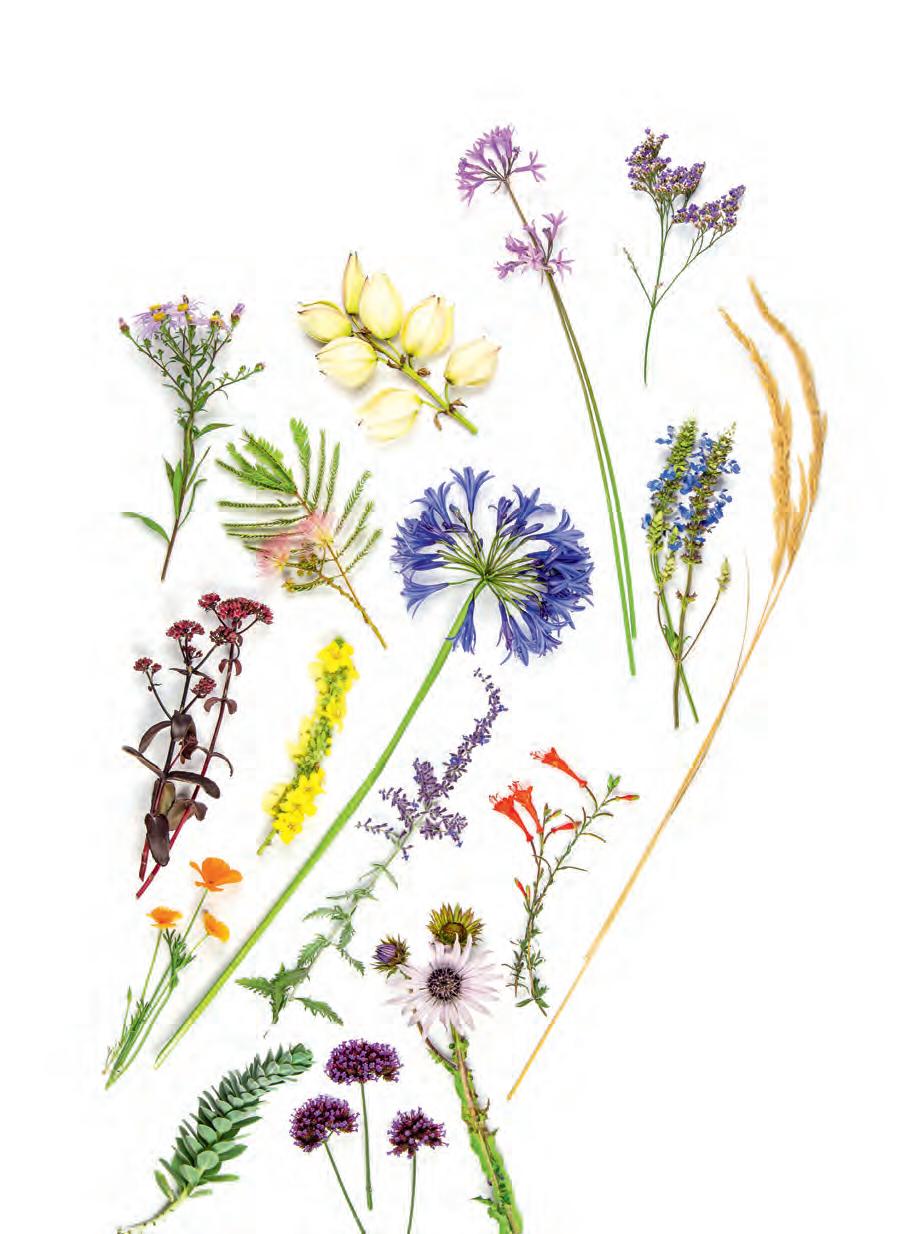






































The last postbag of queries from readers covers lots of subjects- from composting issues to searches for specific plants. If you have a subject you need advice on, please write to us at Country Gardener, Mount House, Halse, Taunton Somerset. TA4 3AD or email alan@countrygardener.co.uk
Can you recommend a pure white dahlia? I have been struggling to find one which doesn’t have coloured edges.
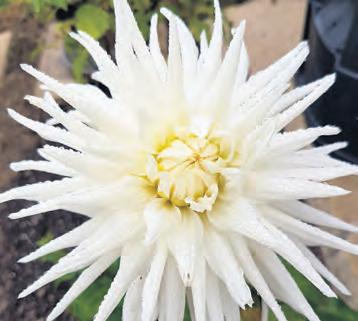 Michela Daviess Portsmouth
Michela Daviess Portsmouth
White-flowered dahlias are particularly versatile. There’s no colour they don’t look good with and, if preferred, they make a lovely addition to a white-themed garden growing with other white flowers. There are several dahlias to choose from but many you will find have a pink tinge to them and would fail the test of being pure white. ‘Kenora Challenger’ is perhaps the best option. This magnificent semicactus dahlia has large, pure white blooms that are sure to draw the eye. It has petals that are broader at the base, distinguishing it from cactus dahlias.


Can I put vegetable stems which have suffered from mildew in my compost?
Andy Porter Minehead‘If in doubt leave it out’ and avoid anything diseased is still the best advice. However, if it is soft material like a tomato stem and one of the less pernicious diseases then the risk isn’t great.

Are centipedes friends or foes in the garden? I seem to have loads in the garden this autumn.

A mole is eating worms in my compost -is this going to harm things and damage the quality of the composting process?
Pete Grayshott Liss
Moles in a compost area is very rare. Moles eat vast quantities of earthworms so let’s assume your mole will stay around and continue to feast on the worms which are helping the composting process. However, the good news is that worms are just one small part of the micro organisms which help to break down your compost so the effects will not be dramatic.
You can relax. Centipedes are not garden pests at all. They do not attack plants, feeding instead on small soil animals and slugs. Not only are house centipedes killing the bugs you really don’t want in your house, they also don’t create any nests or webs. They are considered active hunters and are constantly looking for their next prey. Centipedes aren’t eating your wood or carrying a fatal disease.
I’d like to plant a low growing hedge but I’m not sure where to start when it comes to the right varieties of plants.
 Tom Galsworthy Taunton
Tom Galsworthy Taunton
You could of course keep it classic and simple and opt for box hedging or Buxus sempervirens as it’s also referred to as, is the ideal species for formal, low hedges or borders, as well as being a classic topiary plant. Lonicera pileata or box-leaved honeysuckle is one of the most convincing box lookalikes that can be used in many of the same situations but won’t succumb to box blight or caterpillar. This tough, drought-tolerant evergreen will quickly fill out to form a dense, compact hedge, which can be easily kept to a desired shape and size by trimming in summer or autumn. The display is enhanced by creamy flowers in spring and purple berries in autumn. Compact hebes such as ‘Red Hedge’ make a great low hedge that requires virtually no maintenance. Yearround interest is provided by the small, pointed greyish-green leaves attractively edged with red. The display is enhanced in summer by conical clusters of pale lilac flowers, which are attractive to bees and butterflies.
What houseplants suit a dark porch? We have just moved into a new house and have a rather dark area that I would like to liven up a bit with plants.
Wendy Lewis HorshamDark places aren’t always problem for plants. Plants grow in dark places all over the world, generally inhabiting the under canopy of forests. So, yes there are very specific plants which should thrive in this sort of area and are fantastic for the difficult north facing rooms that are low in light. Mind-your-own-business (Soleirolia soleirolii), a creeping herbaceous perennial originally from Sardinia and Corsica. It can be kept as a ground cover or hung in pots. The threadlike stems can reach up to 50 cm in length and can grow up to 25 cm high in a bush-like manner.
Golden pothos (Epipremnum aureum) is an evergreen climber that develops aerial roots and so makes a wonderful hanging or climbing houseplant for dark rooms. It belongs to the arum family known as Arceae and rarely blooms.
Spider plants (Chlorophytum comosum) belong to the asparagus family known as Asparagaceae. It is a clumping plant, meaning it grows in a large, compact clump and spreads by forming other clumps nearby. Aside from being some of the easiest indoor plants for dark rooms, they are also said to purify the air from formaldehyde, xylenes, and toluene.
My rowan tree has been struggling for the past two years since we had to remove a large poplar tree close by and that may be just a coincidence. I don’t think it is fire blight but could be wrong? It has been a lovely tree but looks rather sad now.

Anything is worth trying so if there are any signs of fresh buds on the tree it might be worth trying to cut out all the dead wood down to where the new shoots are emerging. The picture doesn’t look good however and if you feel cutting out the dead wood leaves you with not a great deal of tree left it might be just better to take it down. The problem may be wilt disease but it’s difficult to tell from the photograph. The damaged and peeling bark doesn’t look too promising though.
I can’t drill into my downpipes to help collect water as they are made of iron. So, is there anything I can do to catch rain with no downpipe?
 Harriet Johnson Wells
Harriet Johnson Wells
You certainly won’t be able to collect anywhere near the amount that you would from a downpipe but just leaving dustbins out for example, open-topped in the rain is better than nothing. There are pieces of kit you can get from garden centres which will divert the water from the gutter and not down the downpipe so that might be worth considering as collecting the volumes of water coming from roofs is the priority.
Can I help my old wisteria to flower? It hasn’t done so for a couple of seasons now.
Sam Coote ExeterProper pruning can help you manage a wisteria and produce a truly spectacular flower show so there’s every chance of turning the problem around. At a minimum, pruning should be done twice a year: once around mid-summer a few months after flowering and again in late winter/early spring before the plant leafs out. Make sure that you do root pruning at least three feet from the trunk, as root pruning too close to the plant can kill it. Using root pruning as a way how to get a wisteria to flower reduces the number of roots and, by default, the amount of nitrogen those roots take up.
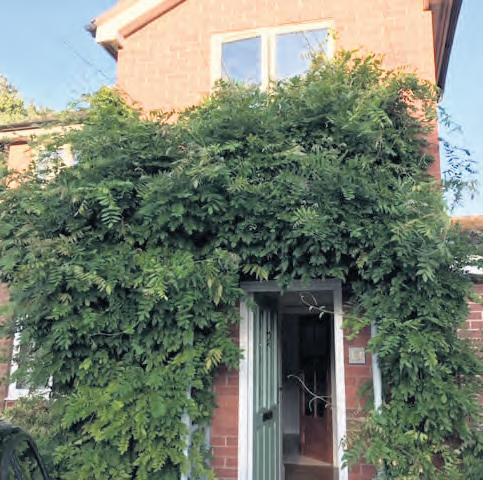
I’ve had a good harvest of quinces from my two quince trees but when I cut into them, they have large areas of brown inside. This doesn’t look right. I am hoping to make quince jelly so should I use these quinces or not? Most of the fruit are affected.
Yes, these fruits are certainly OK to use, and you shouldn’t be put off. When you cut top and bottom and then peel and quarter the fruit put them in lemon juice water. This should stop the browning from getting worse. When you make the jelly, the colouring will have no effect and you should still be able to get a lovely pink colour to the jam.
I am increasingly against having too much lawn in my garden. It is often dry and worn and just doesn’t look good and I want to dig it up and make it part of the wider borders in the garden. Is there anything special which needs doing to make this work?
The biggest problem you will have is the quality of the soil you are reclaiming for your borders. Just think how long the soil has been impacted and just growing grass. It is more than likely to be very poor quality. So, you need a plan to improve the soil over a few months. Lots and lots of organic material needs to be dug in once you have cleared not just the grass but the weeds and grass roots. It won’t be easy or quick, but you must enrich the soil a lot to get it to the level where it can support shrubs and plants in your border
The arrival of coir into the vocabulary of gardeners as a natural bacteria-free composting material has been both rapid and successful.
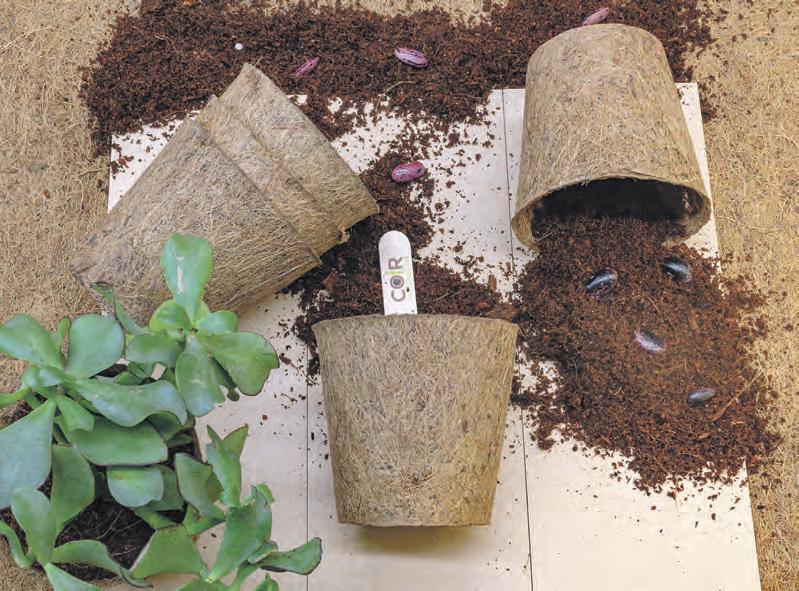
CoirProducts.co.uk was established to bring never-before-seen coir product varieties to the UK and make their sustainable range easily accessible to everyone.
Prior to establishing the retail shop, CoirProducts.co.uk had been in the industry for decades, but they were mainly manufacturing and supplying coir-based products in bulk. The company saw an urgent gap in the market for high quality coir products at economical prices.
They also saw consumers being overcharged for some of the coir-based products they buy, especially in smaller quantities and that many growers and gardeners were not aware of the vast array of coir product varieties that they could use.
Against this backdrop, building on their decades of experience in the industry, CoirProducts.co.uk was launched to help everyone access a wide and innovative range of sustainable coir products at affordable prices. Since its inception, CoirProducts.co.uk, has had the largest portfolio of coir-based products in the UK,. With the commitment to innovate, unique coir bundles, including coir kids bundles, were introduced, a first in the UK market. These specially curated distinct coir bundles combine some of the most popular products.
CoirProducts.co.uk strive to do business differently. They were driven not just by profit, but also by purpose and continue to support the wider horticultural community. They introduced various giveaways to reach growers and gardeners from across the UK via social media, while also sharing inspiring stories and insight from growers. They also continue to help local communities, promoting the planting of trees and supporting children’s charities as well as gardening and mental health charities, from the very start. As a company, such efforts were always part of the ethos, having supported rural economies and children’s welfare initiatives through parent companies.
CoirProducts.co.uk, ensure that ethical business practices are followed in all stages of operations, and there is minimal harm on the environment. They offset carbon in transporting goods to the UK, following processes set by the United Nations Framework Convention on Climate Change (UNFCCC). They also don’t use any unnecessary plastic in packaging.
One of the foremost lessons learnt in the manufacturing and supplying of coir products, was the value of the natural environment.
Website/shop: www.coirproducts.co.uk/shop
Email: hello@coirproducts.co.uk
A struggling rowan treeWinter weeks still provide us with a lot to look forward to. There’s every chance to get out and enjoy fresh air with winter walks and then it won’t be too long before we are looking out for snowdrops
One of the first sights of spring ,gardeners are already impatient for the arrival of these hardy delicate flowers, which continue to arouse such affection.
The dangling white flower of the snowdrop is an instantly recognisable spring sight in gardens, parks and woodland right across the UK. From January to April these plants emerge from the frozen soil and come into flower. Because they are one of the earliest flowering plants to bloom in Britain, snowdrops are often considered a sign of warmer weather ahead and bring the promise of spring.
Although considered a British plant it is possible that our snowdrop is in fact not native at all, as no known record of the species exists here before the late 1700s.
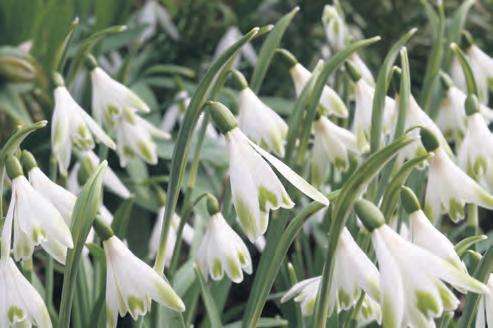
This could mean that snowdrops were brought over from the continent either by accident or for ornamental planting. Whatever the reason, they have since established themselves as one of our most recognised spring flowers with gardeners flocking to see them. Winter gardens are also much more than just snowdrops and the combination of bright winter days and garden walks are one of the great temptations of the winter months.

An RHS partner garden with a Grade I listed medieval priory backdrop the Walled Gardens of Cannington near Bridgwater in Somerset are mix of classic and modern features, including a ‘hot’ border, sub-tropical walk, blue garden, Mediterranean garden, shade border, Southern hemisphere and a winter garden. Home to Somerset’s only botanical glasshouse, featuring hundreds of different species from around the world such as the magnificent jade vine (Strongylodon macrobotrys). There’s also a gift shop, tea–room and specialist plant nursery; plants are propagated on-site. Open from Tuesday to Sunday from 10am, year-round excluding two weeks at Christmas. Closing times vary depending on season.
Please check website at www.btc.ac.uk Tel: 01278 655042


Walled Gardens of Cannington, Church Street, Cannington TA5 2HA
Three years ago, the Victorian walls of Careys Secret Garden were rediscovered after decades hidden from view. Nestled in the heart of 150 acres of rewilding landscape, a rich tapestry of ancient water meadow, rare acid grassland and mixed woodlands, this beautiful space has now been restored and reimagined into a sanctuary for the modern age. This Winter the walled garden will be adorned with hundreds of twinkling lights to create an ‘Enchanted Night Garden’, and a new permanent exhibit of seven full-size pieces of the Berlin Wall has recently been installed to draw juxtaposition between walls that divide and those that unite. Discover more at www.careyssecretgarden.co.uk Garden Wood, Wareham BH20 7PG




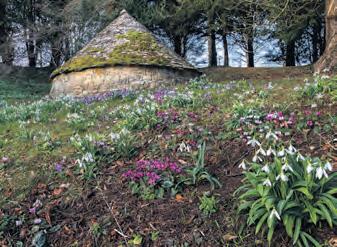
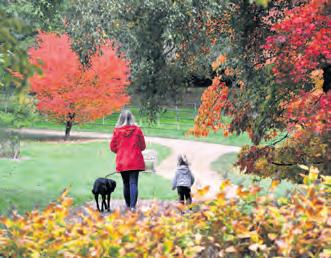
Cerney House gardens is a romantic English garden for all seasons with apparent informality and tranquility. There is a beautiful secluded Victorian walled garden, which is filled with herbaceous borders, and overflowing plants. The end of January marks the arrival of the fabulous winter display of snowdrops and hellebores. A snowdrop trail guides you around the woodland walk packed with drifts of naturalised snowdrops. Rarer snowdrops can be spotted in the walled garden. There is also a selection of plants for sale and there is a potting shed shop. Open daily from 10am to 7pm (dusk) £5for adults and £1 children. Open daily from 10am-7pm (dusk). £5 for adults and £1 children.
Cerney House Gardens, North Cerney, Cirencester GL7 7BX Tel: 01285831300
Email: janet@cerneygardens.com www.cerneygardens.com

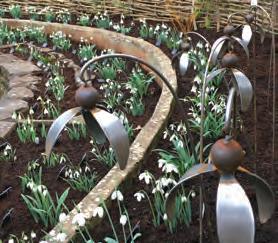
A visit to The Picton Garden at Old Court Nurseries in February allows you to explore this treasure box garden at the very beginning of the gardening year. Over 300 varieties of snowdrops can be found as you meander around the garden, vast swathes light up the borders, and dainty clumps punctuate carpets of purple crocus and vibrant pink cyclamen. hellebores and other spring gems catch the eye while the bright coloured stems of cornus and birch lift the subtle winter flowering shrubs that bring delicious scent to this fascinating garden.
www.autumnasters.co.uk 01684 540416
Scented winter flowering plants transform Batsford into a magical winter wonderland; wrap up warm and explore the 56-acre arboretum in all its winter glory. During February, the arboretum is alive with drifts of beautiful snowdrops, plus aconites, crocuses and hellebores. After a stroll, enjoy a warming breakfast, lunch, or afternoon tea in the recently extended Garden Terrace Café. Batsford Garden Centre is a haven for garden and plant lovers too, offering a fabulous range of quality, affordable plants and gifts. Open daily, dogs welcome on a short lead.
Batsford Arboretum & Garden Centre, near Moreton-in-Marsh, Gloucestershire GL56 9AT Tel 01386 701441
www.batsarb.co.uk
An outdoor winter enchanted lights display is awaiting visitors at the Abbotsbury Subtropical Gardens in Abbotsbury, near Weymouth.
Colourful lights transform and illuminate the famous subtropical 18th century gardens and create a wonderful winters trail in the dark. Visitors will be able to journey through the heart of the gardens for a winter’s walk. In this year’s extended route, experience the rare plants and trees in spectacular colour which highlights the forms, shapes and textures. You can also experience the striking and eye-catching Illuminate alongside the gift shop, plant centre and coffee shop.
It’s certainly the time of the year to enjoy these wonderful gardens.
Buller’s Way, Abbotsbury, Weymouth DT3 4LA

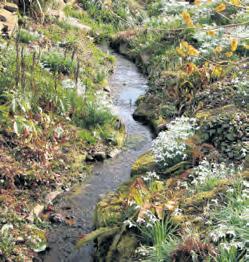
Started by Henry John Elwes FRS with the magnificent Galanthus elwesii, the historic snowdrop collection at Colesbourne Park is the acknowledged home of snowdrops in England. The gardens, restored by Henry Elwes and his wife, have around 350 varieties mixed with aconites, cyclamen, iris, snowflakes, hellebores and winter flowering shrubs.
Visitors can walk beside the beautiful blue lake and along woodland paths of the 10-acre gardens. The gardens are open every weekend in February. Plant sales available. Pre-booked exclusive guided tours also available – contact to find out more.

Colesbourne Park is halfway between Cheltenham and Cirencester on the A435.
Colesbourne Park, Colesbourne, Cheltenham GL53 9NP www.colesbournegardens.org.uk
Somerset’s famous cottage garden at East Lambrook Manor will be celebrating the snowdrop season once again with its fifth Festival of Snowdrops where you can enjoy a stroll through the winter snowdrop garden and view its collection of unusual snowdrop varieties throughout February.

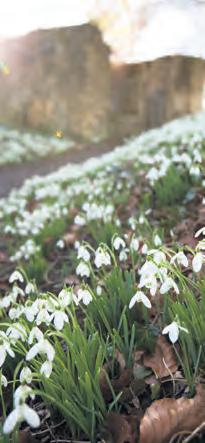

Galanthus, better known as snowdrops, have long been a feature of the garden ever since cottage garden doyenne and early ‘galanthophile’ Margery Fish started planting rare snowdrops in the 1940’s. She first planted them in an area she named The Ditch, which she and husband Walter landscaped from the drainage channel between two orchards. The garden has a collection of around 150 named varieties and many of these are used to make a special display in a raised bed enabling visitors to appreciate the subtle and often not so subtle difference between them all.
Snowdrop tours for small groups will offer an interesting introduction to the genus and highlight some of the more unusual snowdrops in the garden. Around 80 varieties will be on sale in the nursery along with hellebores and other spring bulbs and plants.
The garden is open Tuesday to Sunday throughout the festival from 10am to 5pm. Garden entry £6.75, over 65s £6.25, Groups £6, under 16s free. Tours £3.50. The NGS Snowdrop Open Day is on Thursday, 9th February, with entry money going to charity. RHS members have free entry on Wednesdays. No charge if just visiting the nursery.

East Lambrook Manor Gardens, Silver Street, East Lambrook, South Petherton, Somerset TA13 5HH
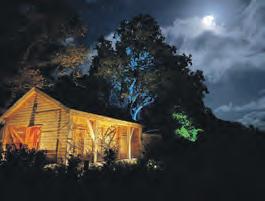
T: 01460 240328




E: enquiries@eastlambrook.com
Starting 25th November until 8th January, explore the enchanted route through the colourful lights. Daily from 4.30pm to 8.00pm, with last entries between 7.00pm and 7.15pm.
Advance online booking. Limited capacity with timed entry.
For tickets visit www.abbotsburygardens.co.uk
A recent national survey amongst allotment holders found that one of the things which frustrated most gardeners was growing onions. The problem was the size. They weren’t consistently big enough.
Big, bold, brazen and most definitely beautiful, championsized onions don’t just look impressive – they have a refined taste to match, with a milder flavour that’s every bit delicious as their smaller cousins.
Of course, big doesn’t always mean better, and it’s certainly the case that standard-sized bulbs are perfectly suited to most kitchens. But sometimes it’s just good fun to go large! There’s really no magic involved, simply the right choice of variety, timing, good soil fertility and generous spacing. The availability of named varieties varies but if they are available any that include ‘Champion’, ‘Giant’ or suchlike in the name give a very unsubtle clue! ‘Kelsae’ doesn’t conform to this stereotype but is well worth seeking out. Typically started off from seed under cover in midwinter, ‘Kelsae’ grows some of the very biggest onions about.
The biggest onions are started from seed in mid to late winter. This early start ensures vigorous seedlings that will be itching to explode into exuberant growth the moment they are planted out into rich, fertile soil. Sow them into module trays then thin the seedlings to leave just one to each cell. Plant them out once the soil has warmed up in mid to late spring.
‘Sets’ are small, immature bulbs about the size of a cherry.

Perversely, planting sets too early can in fact result in smaller bulbs because this greatly increases the risk of the plant bolting, or flowering early, before the bulb has had a chance to fully swell. Onions bolt because excessive cold earlier on in the season fools the plant into believing it has just experienced a full winter.
Big bulbs need plenty of space. This means at least six inches between each plant and 30cm / 12 inches between rows. Planting closer than these recommendations will result in smaller bulbs.
Moist, fertile soil in full sunshine will help plants to grow quickly and happily. Improve the soil with plenty of garden compost or very well-decomposed manure.

Are there any secrets to growing onions?
There is no one secret but many gardeners growing a strong onion crop say it may be necessary to water once or twice a week depending on the weather. Stop watering once the tops begin to yellow and fall over to encourage the bulbs to finish maturing and to avoid rot issues.
Onions tend to grow very well in rich, organic soils with a pH at 6.5-6.8.
What do I feed my onions to grow bigger?
Feed your onions lots of nitrogen to increase bulb size. Because they are a root vegetable, many people believe that onions require lots of phosphorus, however, for increased onion size, nitrogen is your key nutrient. Each leaf that an onion plant produces means an additional ring on the onion.
Can onions be overwatered?
Overwatering your onions could result in rotten bulbs or poor harvests. The onion bulb and roots will rot if the plant cannot completely dry out. Once rot has taken hold, you cannot salvage your onion plants. Another consequence is a fungal infection, which can infect damaged onion plants.

Do onions need full sun?
Onions are one of the most popular vegetables in the home garden. They can be grown for green onions and dry bulbs. Onions are easy to grow. They perform best in welldrained, slightly acidic, fertile soils in full sun.
Do coffee grounds help onions grow?
Yes, they do. Coffee grounds work great for onions. Coffee grounds contain nitrogen which is an essential nutrient for onions. You can have the grounds sprinkled on top of the beds and water them in or allow the rainwater to sink them in.
What happens if onions are planted too deep?
Onions should be planted so that the bulb is barely covered by the soil. If they are planted any deeper, they will grow shoots but are not likely to make bulbs.

Should you hill up onions?
Onions compete poorly with weeds because of shallow root systems. Onions surrounded by weeds in a plot will suffer more than most things Hand-pulling weeds or
Should I let my onions flower?
Dig up any onions that produce a flower stem. Once they start to set seed they won’t grow any more, and they don’t store well either. But onions that have bolted are still edible and will taste fine, so dig them up first and eat them, leaving the others to mature in the ground.
If you plan to use the onions right away, folding onion tops isn’t necessary. However, if your goal is to store the onions for the winter, rolling down onion tops encourages the onion to turn brown and stop taking up water, thus boosting the final process of ripening.
Which part of onion should not be cut?
With a sharp knife, start by cutting off the stem end of the whole onion, where the onion skin bunches together. Try to leave the root end intact and only remove the skin from the section of the onion you’re slicing.
shallow cultivation is necessary; do not ‘hill up’ the soil on onions. Maintain a weed-free bed and apply an organic mulch to maintain soil moisture.The secret to bigger bulbs is the right variety, starting from seed and plenty of space to let them grow big and beautiful
Growing onions from seeds is often a better option than sets
Soil is something gardeners take for granted-often perhaps treating it as an inanimate mass and forgetting that it is a living thing.

There are more organisms in a handful of soil that there are people on the planet. Without soil there would be no gardening and no plants.
The more we dig the soil the more we compact the soil and the more we add chemicals the more harm we do to all the living things within it and the way they all work together.
Not only does digging cut through plant roots it also destroys organisms, fungi and bacteria whose action increases fertility and helps the plants to feed. Chemical fertilisers also disrupt the beneficial relationships between these fungi and our plants, leaving the plants less resilient and less able to cope when we stop adding the artificial fertilisers.
Soil, mud, earth or whatever you want to call it is a living entity, or at least part of an intergalactic universe beneath your feet.
I allocate at least two weeks every autumn or early winter to just working hard at improving my soil. I never have enough home-made compost but what I have gets added. Then I get bulk deliveries of high-quality compost and whatever else I can and add it in.
Soil is a natural environment that supports plant growth. It’s a medium where plants can grow their roots to secure themselves but also to absorb water and nutrients. When the soil is rich and healthy it helps to feed and sustain not just your garden plants but also the whole ecosystem. And that’s because a healthy soil is teeming with healthy organisms from fungi that break down organic matter into nutrients that plants can use right through to worms that work the soil and beetles that feed on slug’s eggs. The mini beasts are food for the next layer in the food chain, which includes our feathered friends and all sorts of other garden wildlife like slow worms, lizards, frogs and toads and our prickly friends the hedgehogs. Most garden soil can be easily improved using materials that might otherwise be discarded. It’s best to compost these materials and rot them right down before adding to the soil. Some materials can be used as a mulch to protect plant crowns and surface roots, while others can be dug straight into the soil. Think of it as feeding the soil rather than the plants, in fact you are doing both at the same time.
It stands to reason that healthy soil is a key component to plant health. After all, that is what plants grow in, so soil that is not good will affect their vigour. Building healthy soil is not only good for plants but can provide other benefits. Sustainable garden soil conserves moisture, prevents erosion, and more.

Enhanced soil should have plenty of organic matter. Organic matter is the basis for building healthy soil. Sustainable garden soil prevents compaction, provides nutrients, conserves moisture while also preventing pooling, prevents erosion, and encourages healthy organisms to flourish. Sustainable garden soil is a layered mixture of stuff.
The top is the humus or organic matter and below that is topsoil. The higher layer breaks down organic matter and rainwater draws it down into the topsoil which contains most of the organisms, like earthworms and beneficial bacteria. It is in this layer where most of the sustainable soil amendments are used. Building a sustainable garden soil for sustainable gardens may need a little help. In a forest, for instance, the soil is naturally enhanced by dropped leaves, twigs, and other organic additives. In the home garden, plants will eventually use up much of the nutrients in soil, which is why we fertilise. If you add compostable organic matter though, you can reduce the need to fertilise plants.

pH is the measurement of the acidity/alkalinity level of the soil. Knowing your own soil pH helps you decide which plants will grow successfully, or what you need to do to increase productivity. Soil testing kits vary in price (they are available at garden centres and on-line), but all of them use a scale of 1 to 14, with the neutral point at 7. Between 1 to 6 indicates an acid soil, and 8 to 14 alkaline. Most vegetables grow in a range between 6.5 – 7, and fruit in 6 – 6.5.
It is best organic practice to work with the soil you have. If, however, your pH is outside the range of 6.5 - 7, then you can make some adjustments. Very acidic (low pH) soils can be adjusted by applying lime. Chalky soils (high pH) will need plenty of compost (such as chicken manure pellets) not just to restore deficiencies in nutrients, but also to improve soil structure.
Malcom Preston studied soil structures and composition for three years with the RHS before taking on senior positions in gardens throughout the east Midlands. He now has two allotments near his Devon home where each autumn he puts many hours into making sure the soil is enriched and well prepared for the next seasonGreen manures are plants grown to improve the soil’s structure and fertility. After growing you dig them back into the soil – leaves, stems, roots and all. They are particularly helpful if you don’t have access to manure or compost, and they can feed a bare patch of land waiting for cultivation, and prevent nutrients being lost or washed away.
They also help keep down weeds, prevent soil damage from extreme weather, and keep the soil loose and aerated. Some can even provide a quick energy boost between spring and summer crops and I would recommend them for anyone setting out to make improvements to their soil.
Soil compaction is a real problem in some gardens. If the soil is too dense with little air space, plants will not grow as well. There are compacted soil fixes, but the best option is to take steps to prevent it and keep soil loose and healthy. Soil compaction occurs when the soil is closely packed together with minimal poor space. Healthy soil should be half soil—sand, silt, minerals, clay, organic matter—and half poor space.
Soils with good structure allow water to infiltrate easily without pooling or running off, and they also hold enough water to support good growth of plants and soil microbes. Healthy soils also require robust microbial activity and diverse microbial populations.
Which soil is most difficult to work?
Clay soils are the heaviest of soil types and are often considered the hardest to work with. They hold onto water and often take longer to warm in the spring.
How can I improve my garden soil?
To feed the soil, and improve its structure, use bulky materials like garden compost, rotted manures or leaf mould. These materials release nutrients slowly, improve soil conditions, and stimulate essential microorganisms.

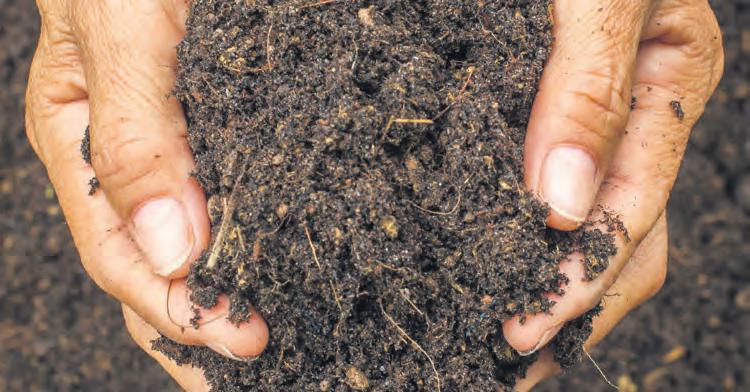
What can I plant in my garden to replenish the soil?
Some cover crops directly add nutrients to the soil by fixing nitrogen at their roots. Examples include winter field beans and peas, clover and vetch. These are all types of legume and are a great choice for sowing before nitrogen-hungry brassicas such as cabbage.

Don’t worry about how you make your compost as long as it works for you. That means compost bins, rotating compost containers, compost heaps, wormeries, anything which provides the enriching compost.
Do mix your green and browns in your composting. Green materials include grass cuttings, annual weeds and the like. Brown materials are woody stems and branches and such things as cardboard, and paper
Don’t add lots of fallen deciduous leaves to your compost heap. They take a long time to breakdown and are better saved for the more gradual process of making leaf mould.
Do try and accelerate composting. The fast method of composting involves collecting all the constituent materials together and building the heap in one fell swoop. The secret to great composting is the heat generated from within the pile and it is that which decomposes all the material and encourages the bacteria to do their work. Such heaps do need turning regularly to ensure the bacteria have plenty of oxygen with which to operate.
Do build your pile using reasonable amounts of ‘ingredients’ and don’t put too much of one thing in the heap. One common failure is adding too many grass cuttings which without proper ventilation will slow the process down.
Don’t be tempted to leave the leaves where they fall, plants will get smothered and lawns will be damaged.
Do rake up the leaves and put them in a simple container. Four posts hammered into the soil with some simple wire mesh sides will be ideal. You can put the leaves into black plastic bags and make some holes but be warned this is a slow process and not always ideal.

Don’t bother shredding leaves such as oak, beech or hornbeam leaves. These will all break down easily and quickly without help. Thicker leaves such as sycamore and horse chestnut will need running over with the mower. Evergreen leaves are best put in the compost bin.
Don’t worry about turning leaf mould. It relies of fungi to break down leaves, a process which happens naturally over time without the need for turning. Leaf mould is a one product phenomenon. Composting relies on a mixture and inter reaction of many organisms and the process speeds up with turning.
The days might be grey and short but if you were to choose one vital job as we enter December in the garden is to get new trees and shrubs into the ground.
It is not a difficult job, but one to get right, if you want your new plants to have the best start in life. The most important considerations are root health, weather, soil conditions and aftercare.
The mild weather in November this year has only made the challenge of planting more straightforward. Previous late autumns have presented gardeners with waterlogged soil but that so far hasn’t been an issue.
Bare-root and rootballed trees and shrubs are only available in autumn and winter. They should be planted immediately, but if this is not possible, then they can be heeled in (temporary planting in the soil to prevent the roots drying out) until planting is possible.
Container-grown plants can be planted any time of the year but are easier to care for if planted in winter, as they need less watering than ones planted in spring or summer.
Drought stress is common with newly planted trees and shrubs. Even in a cool, wet summer, the rain rarely replenishes soil moisture stores fully. The soil may be dry around the roots even when the surface appears moist. Dry, windy conditions are especially likely to lead to water shortages. With experience, it is possible to detect the dull,
lifeless foliage indicative of drought stress but by then the tree has already been damaged. Ideally anticipate water loss, and irrigate to prevent damage.
Overwatering can be a problem especially on poor draining soils and especially with automatic irrigation systems, which leads to rotting roots and symptoms similar to drought. If in doubt dig down with a trowel to the side of the rootball to see if the soil is beginning to dry before watering. The quantity required will vary with soil type but typically 30-50 litres per square metre (four to six watering cans) each week in dry weather during the growing season will be necessary.
Weeds, lawns and other vegetation intercept water before it reaches the roots of newly planted trees and shrubs.
• Keep a vegetation-free circle at least four feet in diameter around the plant for its first three years to help avoid this problem
• The circle can be kept weed free through hoeing, using a mulching mat or use of contact or systemic weedkillers
• Laying mulch over this circle is also helpful, although take care to leave a collar of four inches around the woody stems that is free of weeds.
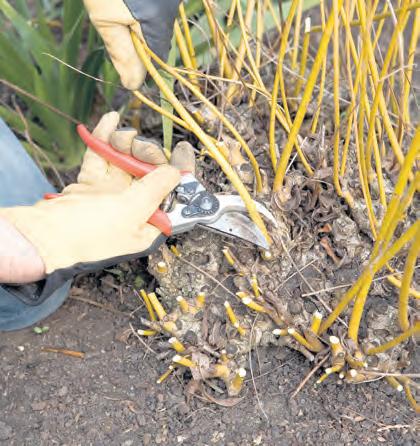
Mulch is a layer of material, at least two inches thick, applied to the soil surface in late autumn to late winter It is used to provide frost protection, improve plant growth by adding nutrients or increasing organic matter content, reducing water loss from the soil, for decorative purposes and suppressing weeds. Examples include well-rotted garden compost and manure, chipped bark, gravel, grit and slate chippings.
All trees and shrubs need to be well ‘heeled in’
Plants will not grow where soil contains too little air or where soil moisture is either excessive or insufficient. Pre-planting soil preparation should aim to improve these conditions:
• Loosen the soil to a depth equivalent to the height of the rootball and over a wide area to eliminate compaction and improve drainage

• Improve soil structure on heavy or sandy soils by incorporating organic matter
• It is not beneficial to apply fertiliser at planting time. However, on poor soils sprinkling an inoculant of mycorrhizal fungi (e.g. Rootgrow) over and in contact with the roots, may help trees and shrubs establish

• If soils are waterlogged over winter consider trees better suited to wet soil, install drainage, or plant on a slight mound, about a foot high and one metre in diameter.
Fertilisers do not need to be added at planting time but can be used a season after planting if the soil is very poor or a boost to growth is required. However, if you are using a mycorrhizal fungi (do not to apply a fertiliser at all as phosphorus (found in general fertilisers and superphosphate) can suppress the fungus.
Corrective pruning on misshapen trees is best carried out while the tree is still young. This may involve shortening or removing any competing leaders and removing damaged, dead or diseased wood. Lower laterals (i.e. sideshoots coming off the main trunk) may also need removing in stages over the first few years if a clear trunk is desirable.
• Most fruit trees require six to eight hours of sunlight for good growth and fruit ripening although as a rule of thumb, cooking varieties require fewer hours. So, it’s useful to know how much sun the site receives in the growing season and whether there are any shady spots.
• The ideal soil for fruit trees is well-drained, uncompacted, loamy soil with a pH of 6 - slightly acidic.
• Ideally there should be at least two feet of soil before you hit any solid substrate like poor soil or rocky soil. Most of a tree’s feeder roots will occur in the top two feet of soil. Trees planted in shallow soils may need staking permanently to stop them falling over in the wind, as will many dwarf rootstocks.
• Most fruit trees do not like to be in for standing water for too long, so avoiding these areas is important. Frost pockets are areas where cold air can’t escape, usually at the bottom of a slope where there is a wall or hedge. The cold air flows downhill and accumulates here and can’t escape, meaning that they stay frosty long after other areas have thawed.
Autumn and winter are the optimal months for planting trees and hedges. Many species of trees can be planted bare-root, most of the natives such as hawthorn, dog rose, field maple, oak, poplars and beech and some more ornamental varieties such as flowering cherries, rowan and crab apple.
Pot grown ornamental trees will do best planted in autumn and winter along with pot grown fruit trees. Bare-root fruit trees can be planted from December and January. Perrie Hale have a wide range of apples, pears, plums and apricots and more unusual varieties such as quince and medlar.
Perrie Hale Nursery is primarily a wholesale nursery but they also sell to the public. They welcome visitors but bear in mind it is a working nursery and there may be tractors moving about, and you might need to bring your wellies!
You can download a catalogue or look at what is available at www.perriehale.co.uk email: faye@perriehale.co.uk
Sales of bare root trees are booming and mild weather this November has made it easier to get them in the ground and ready for lift off in springCutting back willow

planting time. The mycorrhizal fungi literally add a second fungal root system to the plant enabling the plant to explore more soil, find more nutrients and water which in turn leads to better establishment, earlier growth and a better, healthier hedge. Make sure you buy the rootgrow with gel as this can be made up as a root dip and is far more economical. www.rootgrow.couk


Easterhill Herbs and Willow in Starcross in Devon grow over 30 varieties of willow (Salix) for ornamental and wildlife value, living structures, basketry, and craft.
Colourful, ornamental willows make great statement shrubs and wonderful winter interest in gardens. From greens and yellows to bright reds and purples, black, orange, textured or curly, there are so many attractive variations – many of which can be used for floristry, craft, and basketry.
Robust varieties are excellent for creating willow structures in gardens or community spaces. Vigorous and thicker growing willows make effective windbreaks, fences, and hedges.

Willows are beneficial for wildlife with early spring catkins a source of food for pollinators. Willows can also improve soils, can be used as a rooting hormone, dye plant, and has medicinal properties!
Willows can be planted as stem cuttings or rods in the winter making growing willows very simple.
For willow sales, commissions and willow workshops, visit www.reallyusefulplants.co.uk or email reallyusefulplants@outlook.com
Adam’s Apples nursery in East Devon grow the largest range of fruit trees in the west country. This includes over 200 apple varieties, plums, gage, pears, cherries, damson, quince and medlar, all on a range of root stocks to suit your needs. They also sell bare rooted soft fruit plants.
The business is award winning cider makers too, and grow and sell some of the best traditional cider apple trees from Devon, Cornwall, Somerset and Herefordshire.
All the trees and bushes are sold bare rooted, available from late autumn through to spring.

Bare rooted trees are cheaper to purchase and easier to transport than potted trees and are the quickest way for trees to establish and thrive.

Adam’s Apples are happy to offer advice and recommendations for your garden, small holding, farm or community orchard and can deliver trees throughout the U.K. sales@adamsappletrees.co.uk www.adamsappletrees.co.uk Tel: 07521 648502.


Adam’s Apples Nursery, Dulford, Cullompton EX15 2GA
Northcote Hill, Honiton, Devon, EX14 9TH Tel: 01404 43344
in Devon since 1957'
Forcing rhubarb involves preventing light from reaching the crowns of the plants, which triggers the production of delicious pale stalks, perfect for cooking. Forced rhubarb is softer and sweeter than rhubarb harvested in early summer.

There are several things you can do to cut the cost of gardening as the costof-living increases start to have implications for our gardens.

• Grow plants from seeds. You can start planning now on how your borders might look next summer with speedy annual seeds such as cosmos and marigolds early in the season and then sunflowers and zinnias later.
• Make more of your existing plants by dividing them out and then replanting. There are always plants in the garden that will benefit from being split out to make new substantial plants. Don’t just think about dividing into two, try and make four new plants.
• Learn to take cuttings – softwood and hardwood. This is the biggest benefit you can have of making the most of what you already have in the garden without going out and spending more. Hardy plants can be plundered for cuttings. It’s worth really getting to grips with taking cuttings as it can become such an important factor throughout the gardening year. When you buy plants buy small and get them growing faster. You can save lot of money by not buying that more established plant but going for great value plug plants bought in spring.


Chillies are one of the most popular plants to grow at home. It’s an exotic, at tractive, fiery-looking plant that you can use in all sorts of ways, from topping a pizza to spicing up pasta and giving your curry that added zing! Growing your own chillies on a windowsill is fun and will save you money – they will go on pro ducing fruit year after year. They have a long cropping season, so you could be harvesting fresh chillies from late spring to December. And chillies can be frozen, so you’ll never be without that spicy heat in your kitchen!
During summer the plant can sit outside – there’s nothing like a breeze to give it more strength. But to get chillies off to a good start, you’ll need a sunny win dowsill or greenhouse.
You can buy chillies as pre-grown baby plants or produce your own from seed. The best seed varieties are red, yellow, long and short.
The seeds can be difficult to germinate because they don’t like the cold. So wrap in muslin cloth, tie it with some wool and soak it overnight in a Thermos flask warmed to about 45°C.
In the morning, fill baby pots about the size of your palm with ordinary com post. Plant a couple of seeds at a time into each pot about 1.5cm below the soil. Chillies like a steady temperature of 28°C and you’ll want to keep them moist but not drowning. A warm, sheltered windowsill is perfect.
In about three weeks, you should see signs of germination. But don’t worry if they’re slow to emerge – chillies sprout when they’re good and ready.
Growing rhubarb in the dark, and total darkness, accomplishes two things. First, the rhubarb stalks grow faster than usual as the plant searches for light to make chlorophyll. Second, the sweet glucose produced in the rhubarb that would normally be used to grow the plant’s huge leaves is instead stored in the stalks. This means that the stalks of forced rhubarb are sweeter instead of sour.
During forcing, the rhubarb plants will be on the alert for even the tiniest bit of sunlight so that it can begin its natural growing process. Even the beam from a flashlight would be enough to break the forcing! For this reason, rhubarb farmers have been known to pick forced rhubarb by candlelight so as not to disrupt the plants.
Now is the time to start growing agapanthus seeds under cover
Agapanthus, also commonly known as African lily, is one of the great border plants to enjoy and are perennials native to South Africa. They also make an excellent cut flower. So now is the time to start planning growing some from seed.
Loved for their loose globe-shaped summer flower heads in blues, lilacs and whites, they’re ideal specimens for containers. Agapanthus are either evergreen or deciduous. Deciduous agapanthus are hardier than evergreen types, and can survive British winters if grown in a sheltered spot. They’re also able to cope with salty sea winds, making them the perfect choice for a coastal garden.
Grow agapanthus in well-drained soil in a sheltered spot in full sun. Agapanthus do well in pots. Cut back spent flowerheads after blooming and mulch annually with wellrotted compost or other organic matter.

Full sun and a well-drained soil are the secrets to success with agapanthus. Plants can cope in a coastal situation and are not fazed by sea winds and salty air. Agapanthus are drought-tolerant plants and able to cope in a gravel garden that isn’t watered. Agapanthus tend to flower better if their roots are restricted, so do well in pots.
There are two types of agapanthus – deciduous and evergreen. The deciduous types are fully hardy and can be grown in containers or borders in all parts of the UK. The evergreen types are not fully hardy, and are best given winter protection in colder areas.
There’s no better escape for green-fingered travellers than a great garden holiday, where you can enjoy the best of nature in some breath-taking outdoor attractions in Britain and abroad.
The fact is that gardening holidays are about to boom again. From the ancient gardens of Croatia to the baroque gardens of France, the Moorish landscapes of Spain or even the more landscaped gardens of Dorset and Yorkshire the demand for bookings for garden lovers to combine their passion with their holiday is expected to reach record levels.
The last two years has seen holiday trips for the enthusiastic gardening community hit by Covid and Covid restrictions but holiday companies are now reporting that 2023 will see things back to normal or something approaching it.
Garden travel historian and writer Katie Tamworth says so far there remains a rather conservative approach to gardening holidays.
“Long before Downton Abbey the biggest export to come out of Britain was of a more horticultural variety, with
green-fingered gardeners around the world looking to emulate our particular brand of sweeping lawns, glassy lakes and beds of coloured blooms. What has been created is a nationwide selection of great gardens which the public is again keen to see and visit”
“A record number of garden holidays take in floral havens with TV stars and experts, inviting you to discover botanical wonders throughout the UK and allow you to meet the best-loved designers and gardeners to learn gardening tips and tricks along the way.
“One of the key themes for 2023 being reported is the desire for both home grown garden visits and some of the traditional exotic gardens of Italy, Belgium and France.

“If your idea of the perfect getaway is strolling among exotic plants and marvelling at nature’s incredible work, then a garden holiday is for you. Great quality trips to the likes of Madeira, Holland and Italy allow you to browse stunning floral displays while you spend time with top gardening experts.”
From visiting the outstanding natural attractions of Japan
in spring (during the cherry blossom season, no less) to experiencing the gardening event of the year, Floriade, in the Netherlands, these are the top garden holidays to have your eye on for England 2023.
These great garden holidays offer inspiration to the greenfingered.
Nothing is more inspiring to amateur gardeners than seeing how the professionals keep their beds and borders pristine. Indeed, horticulture is such a popular pastime that many companies offering trips to some of the world’s most spectacular gardens.

Gardening is more popular in England than anywhere else and this is reflected in the number of gardens open to visit in England, Scotland and Wales. The concern about Covid is now lifted finally and we are certain to see things get back to normal when it comes to holidays.
There is also an added security available for travellers with a change in attitude of many travel companies of looking more sympathetically about insurances and cancellation policies.
Italian Lakes, Tuscany, Rome area and Amalfi Coast
Visit some of Italy’s most exquisite and gardens. Tailor-made arrangements.
• Flexible departures & durations
• Hotels, flights & transport included
• Local transport by hire-car or by car with driver
• Detailed garden notes provided
• Local garden guides for personalised visits can be arranged
• Full financial protection for all holidays From £1,570 per person



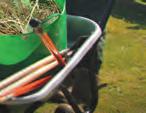























our last visit to Duloe Manor we have chalked up over 80 HPB holidays and now here we are, 20 years later, spending a different kind of family time, in lovely gardens, with a new addition to the clan.”


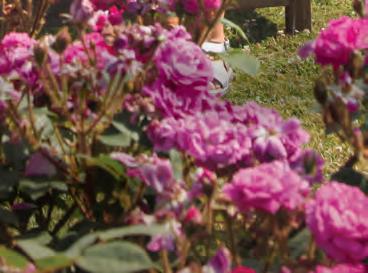


not
to
“SinceLes and Margaret Hill Bondholders holidaying at HPB’s Duloe Manor in Cornwall This advertisement is issued by HPB Management Limited (HPBM) registered at HPB House, Newmarket, Suffolk, CB8 8EH. HPBM is authorised and regulated by the Financial Conduct Authority and is the main UK agent and the property manager for HPB, issued by HPB Assurance Limited (HPBA) registered in the Isle of Man and authorised by the Financial Services Authority there. The Trustee of HPB is Equiom (Isle of Man) Limited, registered at Jubilee Buildings, Victoria Street, Douglas, Isle of Man, IM1 2SH. The Securities Manager is Stanhope Capital LLP of 35 Portman Square, London, W1H 6LR. No medical examination required. HPB is available exclusively through HPBM. HPBM promotes only HPB and is independent of HPBA. Holders of policies issued by HPBA will not be protected by the Financial Services Compensation Scheme if the company becomes unable meet its liabilities to them but Isle of Man compensation arrangements apply to new policies. We are now unable to accept new applications from residents of EU countries and some other jurisdictions. HPB Assurance Limited reserves the right to decline an application at its sole discretion. Head gardener Richard Doney and his team are the heart and soul of the garden here at Duloe Manor Les and Margaret Hill with daughter Julie and grandson Blair at Duloe Manor Lodge Yard, Yorkshire Dales
Although Duloe Manor has these exceptional gardens, it is by no means unique in the Holiday Property Bond portfolio. HPB’s homes are in beautiful locations, and we’ve always been at pains to ensure that the gardens and landscaping surrounding the accommodation should complement, and hopefully enhance, what’s already there, while remaining totally in keeping with the character of the site. St Brides Castle in Pembrokeshire and Lodge Yard in the Yorkshire Dales have both won prestigious gardening awards; the gardens at Upper Norton, near Ludlow, opened for charity as part of the National Garden Scheme, are the perfect place for quiet contemplation, as indeed is the site itself; and at Buckland Court the garden has been recently transformed into what it should be: a proper Cotswold garden. Further afield, Le Manoir du Hilguy, HPB’s Breton château, sits in 11 acres of elegant grounds, which in spring and early summer are ablaze with vibrant rhododendra; El Pueblito de Alfaix, in southern Spain, is made even more perfect by cascades of fragrant bougainvillea; and the award-winning botanical gardens are one of the finest features of El Balcón de Santa Ana, the Holiday Property Bond’s beautiful holiday resort on the Canary Island of La Gomera.

















Imagine being able to enjoy fantastic holidays in all these and many more beautiful locations – HPB’s portfolio currently comprises more than 1,400 holiday homes in over 30 exclusive UK and European destinations.
Now imagine making those dreams a reality for you and your family this year and every year, forever.


That’s exactly what over 42,000 discerning investors in the Holiday Property Bond (HPB) have already done and people like Les and Margaret Hill are delighted to say they’ve “never looked back”.



Like so many families, the Hills have discovered a refreshing new approach to the way they plan and enjoy their holidays.
It’s an approach that’s given them a more affordable alternative to buying and maintaining their own holiday property and it’s one that offers unrivalled flexibility. You can even pass the benefits on to your children and grandchildren so they will have a lifetime of wonderful holidays to look forward to.
It’s never been easier to experience the Holiday Property Bond for yourself, free and without obligation.


Please read “Exclusive holidays for life” below to understand the risks as well as the benefits and then request your free Information Pack today. We’ll send you everything you need to decide whether the Bond is right for you.
You’ll find details of our Bond holiday locations together with information about how you can book a private tour at one of our UK sites or arrange a meeting with a representative – either in person or virtually via an online video call.
“I’m sure you’ll be as impressed as I am.”

The gardens of Villa Lante are amongst the most fascinating and impressive of Italian Renaissance gardens. Created in the late 16th century as a summer residence for a cardinal, the gardens were at the forefront of Renaissance garden design with their wooded areas, statutory, terracing, water features and allegory. Expressions Holidays include a guided visit of the Villa Lante gardens on their garden tour of the Rome area.
Departures are on 10th May, 7th June and 6th September next year with prices from £2,980 per person.
Expressions Holidays Tel: 01392 441250 www.expressionsholidays.co.uk
Away from the crowds and often blessed with unseasonal mildweather ,Cornwall is now proving to be really popular in winter with visitors
Boscrege Caravan and Camping park in Cornwall is a peaceful and picturesque park, set at the foot of Tregonning Hill amongst a myriad of Cornish lanes in an area of outstanding natural beauty. The park, which is open all year through, is situated close to the wonderful Cornwall coast and only a few minutes drive to Praa Sands, one of Britain’s nicest beaches. St Ives, Penzance, Hayle, Lands End, The Lizard Peninsular, Helston and Falmouth and many other Cornwall attractions and beaches. So, if you are looking to take an off season holiday in Cornwall this year in a self catering caravan, camping, or even purchasing your own holiday home then contact Boscrege Caravan and Camping Park. New this year, an exciting development of twin lodges available to buy with a 20 year site licence.
Boscrege Caravan Park, Boscrege, Ashton, Cornwall TR13 9TG Tel: 01736 762231 www.caravanparkcornwall.com
Bath based Floral Tours are a popular group travel operator that specialises only in horticultural and floral tour and have over 26 year’s experience focussing on tailored trips.
The variety of tours on offer remains impressive.
Gardens of North Devon is a tour available throughout the year taking in the sites of well-known and not so well-known gardens and estates.
The different settings and planting styles of the visits give delight, enthusiasm and inspiration for the tasks waiting at home for your return!

Gardens of Yorkshire – Yorkshire is another home-based tour available throughout year focussing on many great gardens
One of the highlights of the Floral Tours programme next year is the trip to the Girona Flower Festival in Spain from 6th to 14th May.
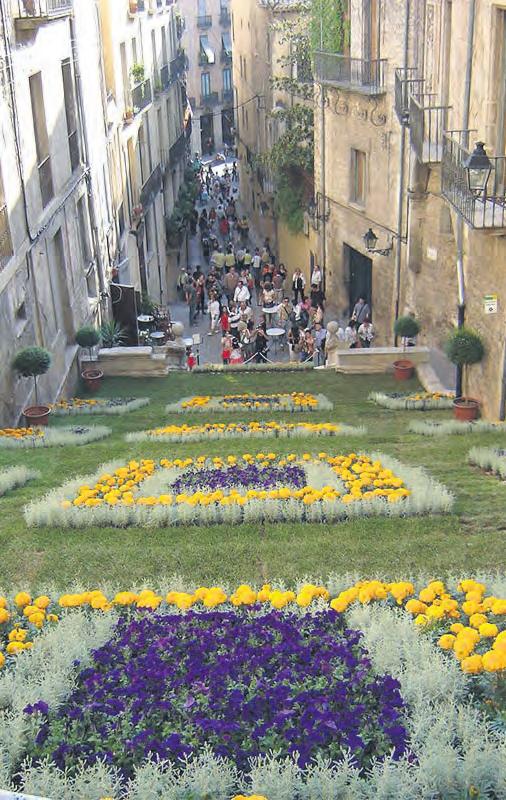
The history of Girona, Temps de Flors is a story of young entrepreneurs who, in 1954, decided to organise the first edition of what they called ‘Concurso Provincial Exhibition of Flowers’.
The festival has grown grew each year,and today is the largest international festival of Girona, an activity that attracts people from all over the world!

This tour is open to individuals, small or large groups and flights from a selection of airports.
Tel: 01225 913106 Email: info@floraltours.co.uk www.floraltours.co.uk
• Floral Tours are working in partnership with Country Gardener to offer readers two tailored tours for 2023: The Monet and Versailles Experience 18 - 22 June 2023, 10 - 14 Sept 2023
The Delights of Yorkshire 9 - 13 July 2023
If you would like to join us on these tours please call Pat at Floral Tours.
• Keukenhof - Holland 23 Mar - 14 May 2023
• Les Journées des PlantesChantilly, France 12-14 May 2023
• UK Garden Tours and Events
We have programs for UK tours and events that we can tailor to your club preferences if this is your choice please give us a call
With a welcoming atmosphere and set in 12 acres of Cornish countryside only two miles from the beautiful sandy beaches of Praa Sands, Boscrege Caravan & Touring Park is the best place to enjoy your Cornish holiday.
Each of our luxury holiday homes comes with a private garden and Wi-Fi. Perfect
for families and couples, we are open all year, and offer seasonal pitches. We offer the following:

• Designated dog walking fields
• Pet friendly accommodation • Comprehensive storage • Luxury holiday homes for sale 01736 762231 • enquiries@caravanparkcornwall.com www.caravanparkcornwall.com
BOSCREGE CARAVAN & TOURING PARK

Welcome back to our popular gardening themed crossword compiled by Saranda which over the past year has become enormously popular with readers. The winning entry to be drawn by us will receive £100 of RHS gift tokens. Completed entries should be sent to Mount House, Halse, Taunton, Somerset TA4 3AD. The closing date for entries is Friday, 17th December. The winner of the November issue crossword was Annie Patterson from Hampshire.
Genus of poisonous plants commonly known as water hemlock (6)
Brosimum alicastrum also known as ramon (8)
Walkway lined with trees or tall shrubs (5)
Weekend meal that might include your garden veg! (6,5)
The ability to put up with something unpleasant (9)
Legally rearing another person’s child as one’s own (8)
Attracted by or adapted to sunlight (12)
North American climbing vine, Clematis virginiana (6,7,6)
A small stream (4)
Part of a plant’s ovary to which the ovules are attached (8)
‘Dahlias and Sunflower,’ a 1936 painting by Sir Jacob _______ (7)
Fit for or providing grass (10)
To burst forth into flower (10)
Someone who cuts grass (7)
Trefolium medium, a species of trefoil (8)
Long stick as used in a garden (4)
Famous floral quote by Gertrude Stein (1,4,2,1,4,2,1,4)
The Jamesonii species of this genus is also called marmalade bush (12)
Obsolete form of eglantine (8)
includes laurel (9)
DOWN 1. Variety of apple introduced by the Normans (7) 2. Genus of plants commonly called bindweed (11) 3. Capable of being drawn out in length (8)
Cut or gather a crop (4) 6. An ornamental design of floral form (8) 7. Midland football team nicknamed the ‘Tricky Trees’ (10,6)
To put into a scabbard (8)
British garden designer (1843-1932) (6)
Brightly coloured flower associated with the Netherlands (5) 9. Agriculture developed alongside industrial methods (12) 10. Popular attraction on the South Bank of the Thames (6,3) 11. Nevertheless (4,2) 12. African blackwood or mpingo (10,4) 17. Difficult characters like cacti or hedgehogs! (7,9) 19. Lathyrus latifolius, an attractive climber (11,3) 20. Achillea ptarmica is commonly called ______wort (6) 21. Most mature and ready for harvest (6) 24. It grows in a dense tuft preventing excessive transpiration (7,5) 27. A sea herb, Ozothamnus rosmarinifolius (3,8) 29. Throughout 365 days (4-5) 31. Pear dish mentioned in Shakespeare’s ‘The Winter’s Tale’ (6,3) 33. Datura stramonium or Jamestown weed (3,5) 35. Having few or no teeth (7) 36. Cicada-like insect that feeds on plant juices (6) 38. Variety of daisy (5) 40. Let it stand! (4)
The NHS reports around 10 million people in the UK have a condition that affects their joints, most commonly in the knees, hands, wrists, shoulders, feet and back.
From genes to diet to lifestyle and even the weather, the influences on our musculoskeletal health are as complex and interconnected as our bones, muscles and joints – but nutrition is always essential.
A diet rich in fruits, dark leafy vegetables and oily fish brings helpful anti-oxidant and antiinflammatory benefits. A growing number of people are also turning to turmeric-based products and nutritional supplements for extra support.
Turmeric has been prized for its health benefits in traditional Indian Ayurvedic therapies for millennia. Now, with its secrets revealed by modern science, the spice has become one of the UK’s most sought-after supplements.
But the science also reveals that not all turmeric supplements are created equal. Many focus on one key active ingredient called curcumin – but miss out on a treasure trove of natural compounds present in turmeric root known as curcuminoids, (of which curcumin is just one) – and some of them are even more powerful.
Curcumin is also very difficult for our
bodies to absorb, and unless it’s made ‘bioavailable’, it can pass through the gut unused, even if we take lots of it.
To overcome these challenges, scientists in Cambridge developed a unique supplement called Turmeric+, featuring the world’s most scientifically researched bioavailable curcumin formulation, and users are saying that restoring their joint health can be life-changing.
One of them is 57-year-old Richard Hamilton, a broadcast journalist for the BBC World Service since 1998, working as a correspondent in Morocco, South Africa and Madagascar.
Regular exercise and enjoying the outdoors has always been important to Richard, but persistent discomfort in his foot became a major obstacle. ‘I was unable to do the things I enjoyed, like cycling to work, going to the gym and running,’ recalls Richard.


‘In truth, I found it a little depressing and I felt quite down in the dumps. I had to give up running altogether.’
‘I found out about Turmeric+ and I liked the science behind it. I didn’t know whether it would help but I thought I’d give it a try.’
Turmeric+ was developed by FutureYou Cambridge, a British developer of innovative supplements backed by extensive scientific research. While developing Turmeric+, they needed to overcome the key challenge with turmeric: making the curcuminoids much easier for our bodies to absorb. They wanted an alternative, better solution to the black pepper formulations so often used, one that would be rich in the full bouquet of curcuminoids.
So the nutritional experts at FutureYou Cambridge used a patented Curcuma Phospholipid Complex formulation called Meriva® that makes curcumin 30 times more absorbable than standard turmeric powder.



‘Our advanced formulation works by using plant-based lecithin to mimic the way the body naturally absorbs curcuminoids after eating turmeric cooked with fat,’ explains Dr Miriam Ferrer, PhD, from FutureYou Cambridge. ‘But it delivers far more than you’d normally get from a meal – the equivalent of 150g of raw turmeric in a single tablet.’
It’s become the most scientifically researched bioavailable curcumin formulation in the world, featured in 45 human studies involving over 2,000 people, each confirming its effectiveness. It’s also been recognised and certified by Informed-Sport for use by athletes.
This is combined with vitamins C and D which contribute to normal function of cartilage and normal muscle function.*
‘After about a month, I tried running again and it felt just like it used to. It’s fantastic. I take one a day and I’m enjoying running and cycling again. ‘I’m so pleased and would recommend it to anyone.’ says Richard.

First things first. I am a traditionalist – in the garden, in the home -everywhere, I think.
I am now retired after spending my whole career in horticulture, managing garden centres and much more relevant to what I want to say, working as a consultant for the Forest Stewardship Council which helps to take care of forests and the people and wildlife who call them home.
In the build up to Christmas an old debate is about to rage again. What is best – a real or a fake, artificial Christmas tree?
Last week I read a very biased article about the benefits of the fake, plastic tree and the only half relevant argument I could make out was that most artificial trees are used repeatedly for several years.
I have worked on growing and marketing real Christmas trees in a forest environment and there is no doubt in my mind that the real thing is the real thing when it comes to buying your Christmas tree.

Some people are trying to tie in Christmas trees with global deforestation and the effects on climate change.
In fact, the opposite is true.
It is the plastic counterparts which are causing all the problems.
Commercial Christmas trees are grown in a production cycle starting with a seedling which grows for eight to ten years and is then cut down to be immediately replaced with another seedling.


They are normally grown on large plantations with trees of various sizes. During their lifetime these trees provide
habitat for wildlife, absorb considerable quantities of carbon dioxide and produce valuable oxygen.
The benefits are even greater if you buy a locally grown one rather than an imported one.
Artificial trees are anything but green.
Most of the trees are imported so there are air miles to consider and when they have outlived their usefulness they end up in landfill where they can remain for hundreds of years. More than 85 per cent of artificial Christmas trees are plastic and imported from China.
The carbon footprint of an average two metre plastic tree is twice that of a real Christmas tree. This is due to the carbon-intensive oils used to make the PVC plastic needed to produce artificial trees.
According to the Carbon Trust, this average two-metre artificial tree has a carbon footprint of around 40kg, more than ten times that of a real tree that is perhaps burned after Christmas.
In other words, you’d need to re-use an artificial tree ten times to negate its carbon footprint, yet it’s estimated that fake trees are used only four times, regardless of improving quality.
A real Christmas tree is completely biodegradable. Of course, if this year’s tree ends up on the rubbish heap, it will have a greater impact (through decomposing and releasing methane) than one that is used for wood chip or burned.
Local authorities often offer a collection and chipping services, with chips used for mulching, or trees can be composted and used as a soil improver. Burning is a
particularly effective way to dispose of a used Christmas tree and reduces potential emissions by 80 per cent over those that are thrown out.
But the biggest argument for artificial trees is they can be used year after year – as I say the only plus point as far as I am concerned.
Let us consider the real tree. Many growers and garden centres sell pot grown trees that can with just a little skill and timing be kept in the garden and reused year after year. So, if you are looking for a real and sustainable tree, where should you start? Firstly, and I want to stress this again because it will be used as an argument for the artificial trees -you don’t need to worry about deforestation when purchasing a real tree: most Christmas trees are grown as a horticultural crop and aren’t felled from pre-existing forests. As a crop, there are things you can look out for:
• Source an FSC Certified tree
• Source it organically
• Source it locally
Christmas trees suffer from similar pest problems as many crops, so pesticide use is often high. However, it’s worth looking for Forest Stewardship Council (FSC®) Certified trees, as they’re grown in a responsibly managed way and often minimise pesticide use.
If possible, source from an organic independent retailer or farm shop, as these providers are more likely to opt for growers who totally avoid pesticides on their farms.
It goes without saying, the more locally the tree is sourced the better, as it reduces the miles travelled, supports the local economy (a lot of work over many years goes into growing Christmas trees) as well as – hopefully – adding an extra element of traceability to the centrepiece of your Christmas decorations.
What’s more, the import of live plants from abroad poses a huge biosecurity risk to plant species in the UK, introducing pests and diseases that can have a devastating effect on our farms and woodland. Opting for a tree with a Grown in Britain certificate guarantees your Christmas tree won’t have been imported, helping to reduce this risk as much as possible.
Remember, don’t be afraid to ask about the environmental credentials of the tree you’re thinking of buying!
The long and short of it is that artificial trees take an ecological toll on Mother Nature- and Father Christmas won’t thank you for that!
With the mantra of ‘Right Plant, Right Place’, Beth Chatto forged a career in horticulture that made her one of the most important gardeners of recent times.
It seems incredible that next year we will be celebrating the centenary of the birth of one of Britain’s great gardeners – Beth Chatto.
She was born on 27th June 1923 at the marvellously named Essex village of Good Easter near Chelmsford, and died at Elmstead Market in the same county on 13th May 2018. Her garden at Elmstead Market which she began with her husband Andrew Chatto in 1960, is one of the most visited in England.
As drought affects so many gardens these days, her work and her writing on creating drought resistant gardens in an ecological and sustainable way, is perhaps even more widely relevant today than ever.
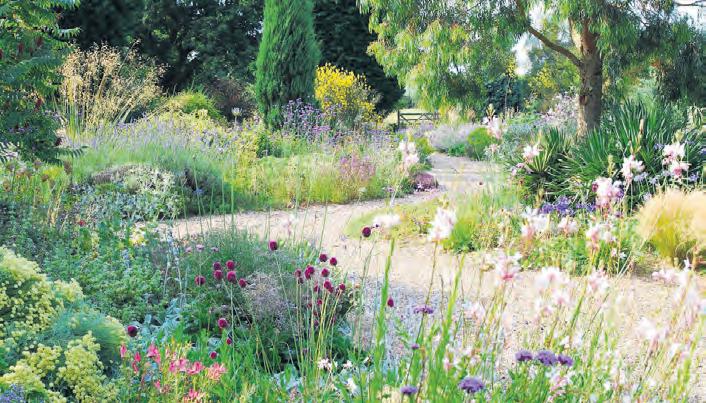



The Beth Chatto Gardens remain open to the public, and visitors can see how a bramble-
strewn piece of desolate farmland was transformed. The wasteland of parched gravel, boggy ditches and areas choked by weeds became a paradise of seven and a half acres full of plants adapted by nature to thrive in such conditions. Right plant, right place, was Beth’s mantra, and it serves every gardener well to remember it.
In the 1970s and 80s she won ten gold medals at RHS Chelsea Flower Show. She was awarded the OBE and the coveted RHS Victoria Medal of Honour for her work, and received many other horticultural awards. Her numerous books included Drought Resistant Planting: Lessons From Beth Chatto’s Gravel Garden, published in 2016 just two years before her death. Her first book, The Dry Garden, came out in 1978, followed by The Damp Garden in 1982, and several books on gardening in areas considered by many gardeners to be difficult: shady areas, woodland, as well as gravel.
One of her most popular books, originally published in 1998 and reprinted in 2013, is Dear Friend and Gardener: letters exchanged between Beth Chatto and Christopher Lloyd. The celebrated gardeners had many differences of opinion and gardened in different ways, but a great friendship had been forged and their letters are full of colour and insight.
After working as a teacher she married Andrew Chatto in 1943. His lifelong interest in the origins of plants influenced the development of the Gardens and the use of plants to this day.
Following Andrew’s retirement, in 1960 the Chatto family built their new home on the wasteland that had been part of the Chatto fruit farm. Low annual rainfall in the area just added to the problems at the site. Andrew’s plant research was invaluable and helped by his knowledge Beth selected plants for a series of gardens that could thrive under the different conditions. Through gifts of seeds and cuttings a large collection of unusual plants and a good knowledge of propagation was acquired.
In the late 1950s Beth Chatto became involved in the Flower Club movement, lecturing, opening new clubs and demonstrating flower arranging. By 1967 the Flower Club members were an enthusiastic audience for unusual plants. Requests for catalogues followed and from a small hand typed sheet a mail order business and plant nursery was born.
In January 1975 ‘Unusual Plants’ exhibited at the RHS Hall, Westminster, winning a Silver Medal and gaining the first press coverage. From 1977 Beth Chatto and her stand of ‘Unusual Plants’ went on to win ten consecutive Gold Medals at RHS Chelsea, and as well as publishing her books, Beth lectured around the world and wrote articles for magazines, newspapers and online.
In her last years she was able to get out into her beloved gardens fairly regularly on her electric scooter, chatting with staff and visitors, sharing her deep love and profound knowledge of planting.
When you arrive at the Beth Chatto Gardens there’s a choice of contrasting areas to explore: the Gravel Garden with drought-tolerant plants, the Scree Garden with its Mediterranean-style alpine planting, the Water Garden, the Woodland Garden with shade-loving plants under a canopy of oaks, and the Reservoir Garden which has been redesigned in Beth Chatto’s style with a mix of bulbs, perennials, trees, lawn and seats. Many of the plants can be found in the adjoining plant nursery.
The Gravel Garden was created from a car park, originally as an experiment, and has never been watered. Despite being in one of the driest parts of the country, not being irrigated, and having poor, free-draining soil, it has become renowned for its spectacular display of drought-tolerant plants. Wide gravel paths meander among perennials and grasses that look good in all seasons.
Writing to Christopher Lloyd in June 1996 Beth Chatto said the gravel garden in spite of a long drought “looks magnificent: the drought tolerant plants, alliums, foxtail lilies, helianthemums, tall woolly verbascums, honeyscented clouds of crambe, soft blue catmint, and still weaving thro’ it all, the electric green of euphorbias.
“I try to make time to walk round it every day, to enjoy every individual player as well as the combinations which contribute to the overall landscape effect.”
In her 91st year Beth Chatto set up an educational trust to develop educational opportunities for everyone, with courses, workshops, projects and activities, for all ages, and to promote wellbeing and enjoyment in the outdoors. From offering RHS Theory qualifications to forest schools for children in a wild garden area, the Beth Chatto Gardens continue the aims and ideals of its founder.
Her mantra ‘Right Plant, Right Place’ is as relevant today as ever.
Beth Chatto Gardens, Elmstead Market, Colchester, Essex CO7 7DB www.bethchatto.co.uk
Hostas are very strong plants and feel at home in many places. It may be one of the reasons why they are very much back in fashion and making stunning appearances in gardens after a period where their presence was a bit questioned.
With their beautiful leaves and ease of care, these perennials are very popular right now. There is plenty of choice in colours and patterns: from dark green to blue and from spotted to variegated.
Versatile hostas will bring you months of joy, year after year!
Hostas are low maintenance landscape plants. They look good without much planning or upkeep. You can avoid a spotty look by clustering multiple specimens of the same cultivar. By massing them together, you give them more visual weight and they don't end up looking like an afterthought.
tolerate more sun. They look great in ornamental pots, in a mixed border, on water banks and as solitary plants. The lowest variety will grow to about ten centimetres, while the tallest can grow higher than a metre.
Keeping snails away
Many hostas suffer from slug infestations. Fortunately, there are plenty of environmentally friendly methods to protect your hostas against snails. A regular snailcatching session at dusk will go a long way. Setting up a wide circle with broken shells or coffee grounds around your plant (or pot) can also work as a slug barrier.
Spraying hostas with garlic powder dissolved in water should also keep snails at bay.
What happens if you don't cut back hostas?
The good news is that hostas, also known as plantain lilies, are tough and forgiving plants. Even if you forget to prune them at a certain time or neglect to prune them at all, they'll still survive just fine, even if they don't look their best.

Do you cut back hostas for winter?
As a general rule, hostas should be cut back in the late fall. Start with leaves that have wilted or turned brown.
Healthy leaves can stay a bit longer to help the roots store needed energy. If 25 per cent or more of the hosta is dying, you will know it is time to cut it back.
Do hostas have a lifespan?
Hostas require little care and will live to be 30 or more years if properly cared for. While most known for thriving in the shade garden, the reality is more nuanced. The ideal situation is dappled shade.
growing to 12” tall and 18” wide. Its bold, substantial foliage brightens the garden. The thick, rounded leaves emerge bright gold with a medium green margin in the spring.
Hostas naturally begin to to brown and die back in fall. Cut back all the foliage after the leaf margins begin to yellow or brown. Remove all the foliage at the base of the plant and dispose of or compost it. Hostas don't require watering once the foliage goes dormant.
Hostas originate from northeast Asia. In 1784, the first seeds were brought from the Chinese port of Macau to the Jardin des Plantes in Paris. Initially a true collector's plant, today this perennial is loved by a varied audience. This is hardly surprising, given the beautiful leaves in all sorts of sizes, shapes and colour variations from bluegrey to variegated white-green. What's more, in summer, graceful stalks bearing white, blue or lilac flowers also make an appearance.
Hostas like moist soil and organic fertiliser. Most hosta species thrive in a semi-shaded spot. The guideline here is that blue-leaved hostas do well in the shade and that yellow-leaved ones can handle a little more sun. The more variegated the leaves, the less sun they will tolerate. Hostas with thicker leaves, on the other hand, can
Do hostas multiply by themselves?
Hostas can spread, either through underground runners or seeds. Rhizomatous Hostas that spread underneath the soil are the worst offenders. These varieties will spread almost indefinitely. Non-rhizomatous varieties will grow in clumps that reach a mature width.
What happens if you don't cut back hostas?
The good news is that hostas, also known as plantain lilies, are tough and forgiving plants. Even if you forget to prune them at a certain time or you neglect to prune them at all, they'll still survive just fine, even if they don't look their best.
What is the hosta of the year for 2022?
The 2022 selection is 'Island Breeze'. This is a small hosta,
• Hostas are also known as plantain lilies.
• There are more than 7,000 different hosta varieties.

• The plant got its name from Emperor Franz I of Austria's physician: N. Th. Host (1761-1834).
• Some hosta flowers smell divine!
• Hostas are not evergreen. In autumn, this perennial will die back, and sprout again in the spring.
• Hostas are perfectly hardy. Some varieties can easily handle temperatures as low as -40° Celsius, including in pots!
• Variegated hostas are also known as streakers, and no two leaves are ever the same.


People wanting an allotment are facing waiting lists of up to three years in parts of Hampshire and Dorset.
Across the two counties nearly 2,000 people have their name on a waiting list for a patch of land.This number is significant given new research which has established how important allotments are for growing urban food and the impact on positive health of owning an allotment.
The rising cost of living and the impact of the pandemic are thought to be behind more people wanting to grow their own.
One council official where people are waiting on average three years for an allotment, said: "We noticed that during lockdown and afterwards the community aspect is important for keeping in contact with others, it's invaluable."


"I know produce is important but that's only one aspect of an allotment, for our plot-holders being outside if you haven't got a garden, tending to your own patch of land is an activity and it's exercise and it's also so good for your mental health," she added.
Stephen Atkinson, who grows vegetables on his allotment in Adelaide Street, Carlisle, said: "I enjoy the fresh air and the exercise and I enjoy the company and banter with the other people here, I love it."
Rachel Ridley, who works as a staff nurse at the city's Cumberland Infirmary, said she also enjoyed keeping an allotment.
Ms Ridley said: "It's just brilliant, being here without any mobile phone, I'm back to nature with nothing to distract me and the produce we get is just fantastic."
A pilot study in Brighton and Hove has backed up the importance of allocating allotments to gardener as it shows how vital the system is to urban food production shows value of urban food production.
A second study also established how vital allotment can be for health and wellbeing.
The potential contribution of allotment gardens to a healthy and active life-style is increasingly recognized, especially for elderly gardeners. However, few studies have empirically examined beneficial effects of allotment gardening. In the present study the health, well-being and physical activity of older and younger allotment gardeners was compared to that of controls without an allotment.
After adjusting for income, education level, gender, stressful
life events, physical activity in winter, and access to a garden at home as covariates, both younger and older allotment gardeners reported higher levels of physical activity during the summer than neighbours in corresponding age categories. Allotment gardeners of 62 years and older scored significantly or marginally better on all measures of health and well-being than neighbours in the same age category. Health and well-being of younger allotment gardeners did not differ from younger neighbours. The greater health and well-being benefits of allotment gardening for older gardeners may be related to the finding that older allotment gardeners were more oriented towards gardening and being active, and less towards passive relaxation.
Participants were provided with calculators which told them how much it would cost them to buy the food they were growing at the supermarket and how dependent their yield was on insect pollination.
There are 10,435 allotments in the UK, spanning 7,920 hectares, according to 2019 figures from the Office for National Statistics. A recent survey by the Association for Public Service Excellence found that 37 per cent of councils report more than 1,000 people on waiting lists for allotments and over a third of councils are looking to increase their allotment provision amid a huge rise in demand during the coronavirus pandemic.
Following fears over food insecurity after Brexit, Nicholls said more could be done in the UK to use urban spaces to produce food and incorporate shared plots into new housing developments.
“The UK imports approximately £8bn of fruit and vegetables each year, but our results show that green spaces in cities, such as allotments and community gardens, could play an important role in meeting that demand at a local scale.”
Nicholls is also collaborating with researchers at the University of Calcutta in Kolkata who are looking at urban food production in India.
The study by the University of Sussex found that volunteer urban growers in Brighton and Hove were able to harvest 1kg of insect-pollinated fruit and vegetables per sq metre in a season – which researchers said put their yields within the range of conventional farms.
The project, which analysed the yields of 34 “citizen scientists” growing fruit and vegetables on their allotments, gardens and balconies, found that despite limited pesticide use they were each able to grow an average of £550 worth of produce between March and October.
Berries were the most attractive crop to pollinators, the study found.
Across the two-year period, volunteers recorded more than 2,000 pollinating insects among their crops. The most common were bees, which accounted for 43 per cent of all flower visits.
Dr Beth Nicholls, who led the study, said: “The growing was surprisingly productive. And some people were harvesting a lot more than that – up to 10kg per sq metre. And this is just in insect-pollinated crops, so it’s an underestimation really.”
“In a world of increasing urbanisation in both the developing and developed worlds, producing food in and around cities has the potential to improve both nutritional and health outcomes, alleviate poverty and simultaneously provide habitat for wildlife and create sustainable cities.”
THE JOINT EFFECTS OF GREATER URBAN FOOD PRODUCTION AND INDIVIDUAL HEALTH BENEFITS CONTINUES TO DRIVE THE NEED FOR MORE LAND TO BE GIVEN OVER TO PRIVATE GROWING
More could be done in the UK to use urban spaces to produce food and incorporate shared plots into new housing developments” Allotments can rival the productivity of conventional farms, according to new research.


Apples, pears, plums, apricots, and peaches are members of what family of flowering plants?
True or false. Daffodil bulbs can be used in place of onions in many recipes?


What is the common name for Salix babylonica?



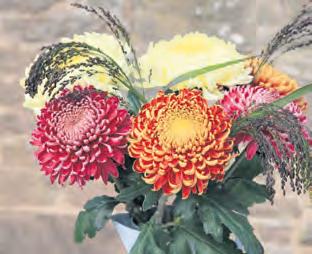
Which flower is also the goddess of the rainbow in Greek Mythology?

campaign encouraged the British population to use gardens, parks and sports pitches to grow vegetables during World War Two?
charity was founded in Devon in 1972 by farmer Kenneth Watkins?
were brought to Britain from Germany by Sir Charles Isham in 1847?
is pomology the study of?
Which king created the Hanging Gardens of Babylon?

Which tree was traditionally planted in graveyards and is associated with eternity?
What word is used to describe plants that like acid soil and will not grow in alkaline soils?
Which fruit was cultivated from crossing a blackberry and a raspberry?







01269 862191


GLORIOUS NORTH DEVON. Only 9 cosy caravans on peaceful farm. Wonderful walks in woods & meadows. Easy reach sea, moors & lovely days out. £125-395pw. Discount couples. Nice pets welcome. 01769 540366 www.snapdown.co.uk



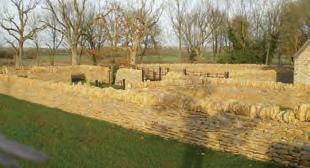
CORNWALL, NEAR ST JUST. Chalet open all year, sleeps 2/4. Nearby gardens, coast, golfing. Prices from £350pw. 01736 788718

BOSWORLAS NEAR SENNEN/ST JUST, CORNWALL. Cosy Cottage, rural views, Sleeps 2-4 01736 788709 www.bosworlas.co.uk

WYE VALLEY/FOREST OF DEAN. Fully equipped 4-star single storey cottage. Two bedrooms both en-suite. Central heating/bedlinen provided. Rural retreat with shops/pubs one mile. Short breaks available. Warm welcome. Tel: 01594 833259 www.cowshedcottage.co.uk


NORTH DEVON NEAR CLOVELLY. 3 delightful cottages situated in 12 acres of idyllic countryside. Sleeps 2-4. 1 Wheelchair friendly. Prices from £190p.w. Brochure: 01237 431324 www.foxwoodlodge.co.uk

Tap, tap, tap on the window and it seems as if a bird is waiting to get into the house. Lots of species have been noticed doing this. The usual explanation is that a male bird, high on hormones and fiercely territorial has spotted what it thinks is a rival in the reflection and wants to attack it. The bird may return day after day to see off this supposed threat, A piece of white card on the inside of the glass or even a bit of cling film on the outside helps dim its reflective quality.
Some birds have the rather strange ability to change their apparent shape by raising or lowering their feather tracts. Starlings for example can flare its throat feathers to show off: the goldcrest can raise its head feathers to show off a golden crown. However of all the garden birds the jay has perhaps the best hair raising trick. Its normally flattered head feathers rise into a Mohican like hair style, changing its look completely
From time to time you may notice a bird flat out on the soil or grass, wings spread, tail flared and looking as if it’s flaked out and perhaps in trouble. This normally happens in a sunny part of the garden and can happen at any time of the year when the sun has real warmth. It isn’t sunbathing by the way. It is the bird’s natural instinct to let the warmth of the sun permeate right down to the skin and flush out any annoying parasites. After a few minutes the bird will actively preen to weedle out the mites.
At dusk most garden birds fall silent but not the blackbird. You will often see the blackbird in the garden late at night –

the last one out of an evening. The reason is that blackbirds like to roost in loose groups but this involves birds from neighbouring gardens heading into the territory of resident birds for the night. This desire to get together gets mixed up with squabbling over who is top dog and its often the dusk time squark of the blackbird which is strongest.
Let’s get together lads !
What is a starling murmuration? It's been called the greatest wildlife spectacle in Britain and is remarkable to witness. Studies suggest that starlings congregate in these remarkable 'murmurations' to deter possible predators, which are confused by the swirling mass. Despite a recent drop in their overall population, you can still witness the mesmerising sight of thousands of birds performing their aerial dance at dawn and dusk.
Starlings have extremely fast reaction times and can make changes in their flight direction in a split second. It is now generally thought that flocking helps to protect the starlings from predators. We all know the old saying that there’s safety in numbers.


Put simply, the more starlings there are in a flock the smaller chance everyone has of being caught by an airborne predator. Studies have even shown that individual starlings move around within the flock and try to minimise their time on the edge where they are most vulnerable. They are gregarious birds, living in flocks for much of the year. But it is in winter, when starling numbers are boosted by migrant birds from colder parts of Europe that these aerial displays are at their breath-taking best.
From November to February, this amazing sight can be seen across Sussex and in particular displays are regularly seen over the Somerset Levels.


We are all used to seeing garden birds splashing around in a bird bath with droplets of water flying all over the place. Sometimes however you will see birds doing something similar in a bare dry part of the garden or even in the dry dust of a garden drive. You would imagine that getting dirty would be the last thing they would want but it’s all about flushing out bird lice which can be an itchy problem for a lot of birds.
As part of the pigeon courtship a single male will nod his head at the female which takes his fancy and spread his tail feathers to communicate his interest. The birds look directly at each other, and if the hen likes what she sees, she will nod back.
Pigeons chase each other for two reasons: The males chase females for pairing/mating. The males chase away other males for the protection of their family.

We are all aware that male birds sing to defend their territory and attract a mate but there are two of our garden visitors who seem to enjoy singing in a choir! Starling and goldfinch communal singing can be heard throughout the winter. After filling their bellies for the day they head up to the top of the tree as a flock and sing together. It’s thought to be good for group cohesion but there’s recent research they may just enjoy doing it.
Garden birds are always on the go, even throughout the winter and sometimes their behaviours can seem strange, even baffling - so what’s really going on?From top left: Pigeon courtship; starling murmuration; groups singing; sperading wings in the sunshine; pecking at the window
Mark Hinsley sees at first hand some over-reaction when it comes to the problems of ash die back in the south and southwest.
A worrying document recently crossed my desk that had been sent to a country landowner. It informed the landowner of the following:
(To be revealed)... have been conducting a survey of ash trees with ash-dieback along the highway network. It is a serious fungal disease, caused by a fungus (well I never!) called Hymenoscyphus fraxineus (impress them with Latin) and ash across the country are infected (many are – not all). There is no cure or treatment (there is treatment) and infected trees will collapse (or recover – we don’t know which is which yet). This presents a significant health and safety risk (not necessarily), especially alongside roads (not necessarily). So, was this letter sent by a tooth sucking, head shaking, fear purveying con artist? No - it was headed Wiltshire Council. They told the landowner that they should arrange to have their land assessed by a competent tree surgeon in order that the affected trees can be removed and to confirm that this was being done.
It threatened them with Section 154 of the Highways Act 1980 which gives the Highway Authority the power to serve notice to landowners to remove vegetation likely to cause a danger or nuisance to highways users.
The highway survey appears to have been contracted out to a management consultancy. The management consultancy appears to have contracted out the surveys to a tree surgery contractor who will be happy to give a free quotation to undertake all the felling!
Below is the up-to-date advice from the Forestry Commission: Management and control You are not legally required to take any particular action if you
own infected ash trees, unless your country forestry or plant health authority serves you with a Statutory Plant Health Notice (SPHN) requiring action. This is unlikely.
With the exceptions of felling for public safety or timber production, we advise a general presumption against felling living ash trees, whether infected or not. This is because there is good evidence that a small proportion will be able to tolerate H. fraxineus infection. There is also the possibility that a proportion of ash trees can become diseased, but then recover to good health. These, too, would be valuable for our research, although it is still too early to know whether there are such trees in the British ash population.
However, by keeping as many ash trees standing as possible, we can identify individuals which appear to survive exposure to the fungus and which can be used for breeding tolerant ash trees for the future.



That said, public safety must be the priority, so keep an eye on the trees’ safety as the disease progresses, and prune or fell them if they or their branches threaten to cause injury or damage. In particular, watch for basal lesions (lesions, or cankers, forming near the bottom of the trunk), which can weaken the trunk and make the tree more prone to falling.
There is no known cure, although some fungicides might be effective in suppressing the disease, enabling individual ash trees of value to be saved. These might include trees of high amenity, heritage or cultural value. However, such treatments often must be re-applied periodically, perhaps every year, and can therefore be expensive.
My practice advises the removal of ash trees once the canopy is 60 per cent dead; before that, monitor but retain.
There is no evidence that the trees become dangerous simply through initial infection.
I will leave you, gentle reader, to judge the conflicting advice above and which organisation you trust.



